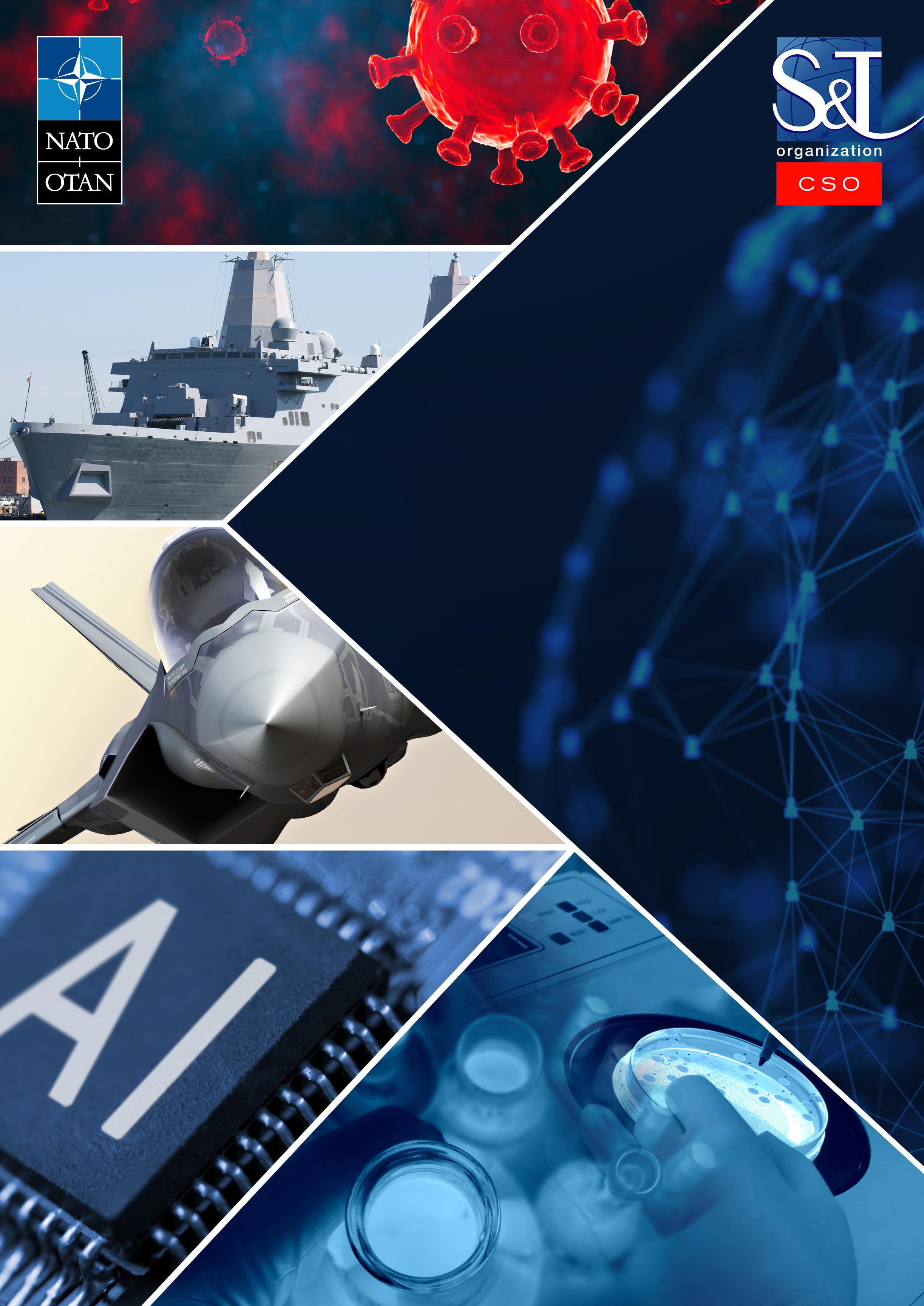
2021 COLLABORATIVE PROGRAMME OF WORK
NATO Science and Technology Organization
Preface
Dr. Pavel ZŮNA, Director of Collaboration Support Office, NATO Science & Technology Organization
Action Officer
Lt. Col. Marek DOBEK (POL), Executive Officer in Operations and Coordination Division of Collaboration Support Office, NATO Science & Technology Organization
Contribution and Supervising
Major General (rtd) Philippe MONTOCCHIO, Deputy Director of Collaboration Support Office, NATO Science & Technology Organization
Col Daniel GALLTON, PhD (USA), Head of Operations and Coordination Division of Collaboration Support Office, NATO Science & Technology Organization
ISBN: 978-92-837-2338-7



Preface 1 #We are STO 2 How to Join Us 4 STO Panels, Groups and Activities 5 2021 Business Meetings (PPW/PBM/STB) 7 Structure of 2021 Collaborative Programme of Work 8 2021 Budget General Information 9 S&T Strategy, Priorities, Strategic Initiatives and Emerging & Disruptive Technologies: “What, Why and How” 10 Applied Vehicle Technology Panel (AVT) 12 Human Factors and Medicine Panel (HFM) 18 Information Systems Technology Panel (IST) 23 NATO Modelling and Simulation Group (NMSG) 26 System Analysis and Studies Panel (SAS) 29 Systems Concepts and Integration Panel (SCI) 33 Sensors and Electronics Technology Panel (SET) 36 STO Events in 2021 CPoW 39 Lecture Series in 2021 40 Technical Courses in 2021 41 Symposia in 2021 42 Workshops in 2021 43 Specialists’ Meeting in 2021 44 Exploratory Teams 46 Emerging and Disruptive Technologies 48 New 2021 Activities By Type 57 New Activities to Start in 2022 60 CPoW in Numbers 61 Acronyms and Abbreviations 63 List of Figures Figure 1: Activity Lifecycle 3 Figure 2: All Unclassified STO Scientific Publications are Available on Our Website at: www.sto.nato.int 3 Figure 3: Where to Find the Points of Contact? 4 Figure 4: CSO 2021 Budget Composition 9 Figure 5: Number of AVT Panel Activities per Type, as of 1 January 2021 13 Figure 6: Number of HFM Panel Activities per Type, as of 1 January 2021 19
i
Table of contents



List of Figures (Continued) Figure 7: Number of IST Panel Activities per Type, as of 1 January 2021 23 Figure 8: NMSG Mission-Oriented Research 26 Figure 9: Number of NMSG Activities per Type, as of 1 January 2021 27 Figure 10: Number of SAS Panel Activities per Type, as 1 January 2021 30 Figure 11: Number of SCI Panel Activities per Type, as of 1 January 2021 33 Figure 12: Number of SET Panel Activities per Type, as of 1 January 2021 36 Figure 13: Trends in CPoW, 2011 – 2020 62 List of Tables (Continued) Table 1: 2021 Business Meetings 7 Table 2: 2021 CPoW Composition (as of 1 January 2021*) 8 Table 3: 2021 CSO Budget Projections per Category* 9 Table 4: AVT Activities Continuing in 2021 14 Table 5: AVT Activities Starting in 2021 16 Table 6: AVT Activities Starting in 2022 17 Table 7: HFM Activities Continuing in 2021 20 Table 8: HFM Activities Starting in 2021 22 Table 9: IST Activities Continuing in 2021 24 Table 10: IST Activities Starting in 2021 25 Table 11: NMSG Activities Continuing in 2021 28 Table 12: NMSG Activities Starting in 2021 28 Table 13: SAS Activities Continuing in 2021 31 Table 14: SCI Activities Continuing in 2021 34 Table 15: SCI Activities Starting in 2021 35 Table 16: SCI Activities Starting in 2022 35 Table 17: SET Activities Continuing in 2021 37 Table 18: SET Activities Starting in 2021 38 Table 19: Lecture Series 40 Table 20: Technical Courses 41 Table 21: Symposia 42 Table 22: Workshops 43 Table 23: Specialists’ Meeting 44
ii
Table of contents



Table 24: Exploratory Teams Continuing in 2021 46 Table 25: Exploratory Teams Starting in 2021 47 Table 26: Space 48 Table 27: Big Data 49 Table 28: Artificial Intelligence 51 Table 29: Autonomy 53 Table 30: Hypersonic 54 Table 31: Quantum 55 Table 32: Biotech 55 Table 33: Novel Materials 56 Table 34: New Lecture Series in 2021 57 Table 35: New Specialists’ Meetings in 2021 57 Table 36: New Symposia in 2021 57 Table 37: New Technical Courses in 2021 57 Table 38: New Task Groups in 2021 58 Table 39: New Workshops in 2021 59 Table 40: New Support Projects in 2021 59 Table 41:New Activities to Start in 2022 60 Table 42: Involvement of NATO + EOP Countries in 2020 CPoW 61 Table 43: Number of Participants in 2020 CPoW per Country (NATO + EOP) 61 Table 44: Number of Activity Chairs of 2020 CPoW Activities per Country 61 iii
Table of contents

Preface


As we start a new year, I have the pleasure to present in this brochure the NATO Science & Technology Organization’s (STO) Collaborative Program of Work (CPoW) for 2021.
The CPoW materializes the STO’s collaborative business model, which provides a forum whereby NATO and Partner Nations elect to jointly leverage their national resources with NATO’s to define, conduct, and promote cooperative research and information exchange for the benefit of NATO and the contributing Nations.
STO is composed of three executive bodies: the Office of the Chief Scientist (OCS) at NATO HQ; the Centre for Maritime Research & Experimentation (CMRE) in La Spezia, ITA; and the Collaboration Support Office (CSO) near Paris, FRA.
The CSO mission is to provide executive and administrative support to the network of experts that, within the CPoW, conduct defence and security-relevant research and technology development leading ultimately to enhanced operational military capabilities within NATO and the Nations.
In recent years, our goal has been to pursue our long-term efforts in strengthening the CPoW. This collaborative programme is highly appealing to experts and the network has been steadily growing, reaching in 2020 approximately 6,000 scientists, engineers, and analysts originating from 29 NATO and 48 Partner Nations, and representing national laboratories, academia, and industry.
This Collaborative Programme of Work and Budget for 2021 comprises close to 350 ongoing and planned activities (run by Technical Teams). 13 Collaborative Demonstrations of Technologies (CDTs) are planned and more than 100 technical reports and meeting proceedings should be published.
In order to sustain this high tempo and secure effective and qualitative executive and administrative support to the network, the CSO will be reinforced and will implement a reorganization this year, following NAC approval of its new Peacetime Establishment (PE). This reorganization will improve manpower resilience and will provide additional administrative support to the CPoW where needed. It will also synergize structures and processes to improve the network cyber-security, cross-domain coordination, corporate communication, and exploitation of scientific findings to the benefit of our community as well as address NATO Nations‘ and NATO S&T Stakeholders’ requirements for better cooperation and coherence within NATO on S&T matters.
2021 will likely be impacted by continuing COVID 19 pandemic and travel restrictions. Our Technical Teams were not able to meet physically in 2020 and most of the research work was conducted virtually. About one third of the CPoW is currently delayed and some Technical Teams, which require physical meetings such as CDTs and Field Trials, have been postponed until 2021. The ongoing travel restrictions have also had a major impact on our classified Technical Teams and many of these activities have been delayed until 2021 as well. On a more positive note, virtual meetings have provided the opportunity for an increased number of experts to participate and contribute. One of our primary objectives for 2021 is to catch up on the most essential S&T work.
Much of the essential work is related to Emerging and Disruptive Technologies (EDTs). In 2020, the STO published a Technology Trends Report focused on EDTs and the CPoW consisted of approximately 50% of the CPoW activities focused on EDTs and their impact on future main operational capabilities. We will continue to support this NATO effort with short-, mid- and long-term reviews of existing, planned, and proposed activities, across all Panels and Groups, aiming at promoting EDT-related cross-domain research at CPoW level, within the STO with the CMRE and with our NATO S&T Stakeholders.
To conclude, as I have done in previous years, I want to recognize that the core of the CPoW business is managed by the Scientific and Technical Committees of the STO (i.e., the Applied Vehicle Technology (AVT), Human Factors and Medicine (HFM), Information Systems Technology (IST), Systems Analysis and Studies (SAS), Systems Concepts and Integration (SCI), and Sensors and Electronics Technology (SET) Panels and the NATO Modelling and Simulation Group (NMSG)). These seven so-called Level 2 Committees are led, on a part-time basis, by voluntary national contributors who do a commendable job. The entire CPoW network benefits and appreciates their leadership, which is typically in addition to their normal jobs, duties, and responsibilities. Last year, due to the pandemic, the work of all Panel and Group leadership was much more difficult in terms of keeping up the S&T work pace and keeping our network engaged. We warmly thank these volunteers and their Nations for the exceptionally fine work they have done in these demanding positions.
Pavel Zuna Director, STO Collaboration Support Office

1
#We are STO

STO: who are we?
The STO is a NATO subsidiary body created to meet the collective Science and Technology needs of the NATO Alliance and its partner nations. The STO does this by generating, sharing, and disseminating advanced scientific knowledge, technological developments, and innovation resulting from its many activities completed within the Collective Programme of Work (CPoW).
How are we organised?
The organization is led by the Science and Technology Board that exercises governance through the following executive bodies:
• The Office of the Chief Scientist (OCS) provides executive and administrative support to the Chief Scientist to exercise the role of Chair of the Science and Technology Board and as the primary Scientific Advisor for NATO. The OCS promotes the exploitation of the results generated within the CPoW to numerous internal stakeholders and partners.
• The Collaboration Support Office (CSO) provides executive and administrative support to collaborative activities, maintains an active network of scientists, and runs six Technical Panels and one Group that organize technical activities.
• The Centre for Maritime Research and Experimentation (CMRE) organizes and conducts scientific research and technology development and delivers innovative and field tested S&T solutions in the maritime domain to address the defence and security needs of the Alliance.
HOW DOES CSO FUNCTION?/HOW DO WE STRUCTURE OUR WORK IN CSO?
The CSO provides NATO Nations and Partners Nations with a technical forum where researchers and analysts can define, conduct and promote cooperative research and information exchange. The CSO runs its many activities through a collaborative business model. The international collaborative programme of work is carried out in 7 different technical areas. These technical areas are represented by 6 Panels and 1 Group running their scientific effort within several types of scientific activities (see section 4).


2

Activity lifecycle
The Panels/Group take the initiative to create technical activities based upon top-down guidance from NATO and the Nations, and bottom-up initiatives from the NATO scientific community. The Panels/Group usually meet twice a year (in Spring and Fall) during Panel (Group) Business Meetings (PBMs) which are medium-scale, two-to-three day events. Technical activities are organized in teams of national experts with clearly defined scopes and products as goals at the end of the activity. The Activity lifecycle is depicted in Figure 1.

Ideas for new activities may originate from NATO bodies, Panel Members, or scientists or engineers within any of the participating nations. However, it is mandatory that the activity be supported by a minimum of at least four nations before being initiated.
After an activity draft has been put together, a Technical Activity Proposal (TAP) is presented to the Panels/Group for decision prior to the upcoming PBMs. After the submission, a TAP has to be approved unanimously by the Panel. After the PBM, the new activities, which have been endorsed by the Panel, are submitted to the STB for approval through a two-week silence procedure. Following the silence procedure, the activity is officially approved provided that no objection is raised during the two weeks. Depending on the type of an activity, a technical report or a meeting proceedings publication can be generated as a final result.
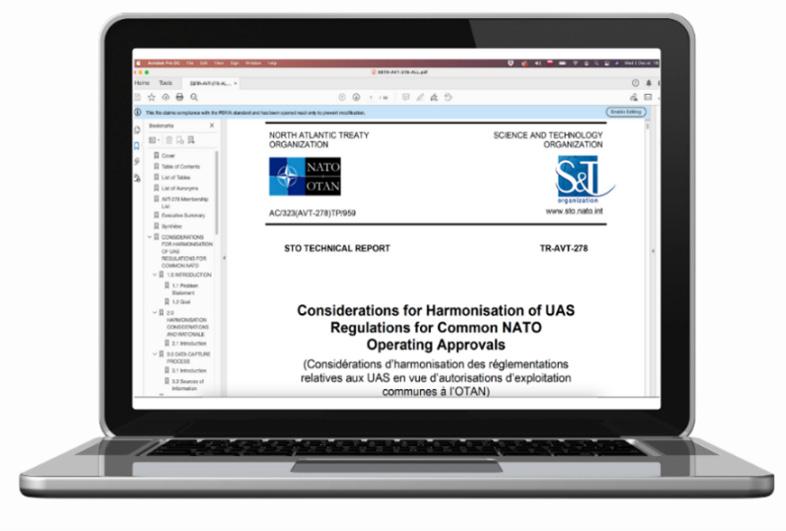

COLLABORATIVE PROGRAMME OF WORK AND BUDGET FOR YEAR 2021 3
Figure 1: Activity lifecycle
Figure 2: All Unclassified STO Scientific Publications are Available on Our Website at: www.sto.nato.int
How to join us

Whether you are a government representative, a military member, a specialist from industry, or an academic interested in any of our research topics, you can join our activities. There are two required steps in order to be a part of the CSO activities:
1) Contact your National Coordinator.
The national coordinator is an individual designated by the nation to facilitate his/her nation’s participation in the STO. The list of institutions responsible for national coordination could be found on our website: https://www.sto.nato.int/Pages/national-coordinators.aspx
After you reach out to a national coordinator, he/she can provide you with more details on how your country is involved in activities and put you in contact with national representatives within a panel.
2) Contact the Panel Executive/Assistant.
If you know which panel you are interested in, you can directly contact the Panel Office that would give you directions on how to join activities. Contact information for each Panel can be found at: https://www.sto.nato.int/Pages/contactus.aspx


4
Figure 3: Where to Find the Points of Contact?
STO Panels, Groups and activities

The scientific and technical committees consist of six Technical Panels that manage a wide range of scientific research activities, and one Group specializing in modelling and simulation. The Panels and Group are the powerhouse of the collaborative model and are made up of national representatives as well as recognized worldclass scientists, engineers and information specialists. The Panels and Group are responsible for proposing and managing the scientific work programme. In addition to providing critical technical oversight, they also provide a communication link to military users and other NATO bodies.
The current Level 2 committee structure consists of the following six Panels and one Group:
• Applied Vehicle Technology (AVT)
• Human Factors and Medicine (HFM)
• Information Systems Technology (IST)
• System Analysis and Studies (SAS)
• Systems Concepts and Integration (SCI)
• Sensors and Electronics Technology (SET)
• NATO Modelling and Simulation Group (NMSG)
Each Panel/Group’s Programme of Work will be carried out by Technical Teams made up of national experts. Prior to launching a Technical Team, when a Panel/Group believes that a particular expertise is required to assist or advise it on the technical merit or feasibility of a specific proposal, an Exploratory Team (ET) is established. An ET is the CSO’s instrument for carrying out a feasibility study to establish whether it is worth starting a bigger activity. During the PBM, each NATO Nation in the Panel/Group is polled to determine if it is willing to allocate resources and participate in a future ET on the topic. If this is the case, the ET finalizes the TAP and submits it to the Panel Office for revision. The step of involving an ET is sometimes omitted if the idea has a strong support and can go straight into a Technical Activity. The ET is, however, an essential supporting instrument for young/new scientists who wish to scope their proposal for a Technical Team.
Technical Teams are assigned by the Panels/Group to perform specific tasks, such as:
• Research Task Group (RTG) – study group, up to 3 years;
• Specialist Team (ST) – quick reaction;
• Research Workshop (RWS) – selected participation, 2 – 3 days;
• Research Symposium (RSY) – more than 100 people, 3 – 4 days;
• Research Specialists’ Meeting (RSM) – up to 100 people, 2 – 3 days;
• Research Lecture Series (RLS) – junior and mid-level scientists;
• Research Technical Course (RTC);
• Support Project (SP);
• Long-Term Scientific Study (LTSS);
• Multinational Exercise (MNE);
• Military Application Study (MAS);
• Advanced Guidance for Alliance Research and Development (AG – AGARDograph).
A Research Task Group (RTG) technical team activity allows researchers from different nations to work together in order to solve a particular scientific research and technology development problem. RTGs are sponsored by the Panel/Group to meet the needs of NATO. RTGs are chartered for a maximum of three years after the initial meeting. Among the activities conducted during an RTG, a Cooperative Demonstration of Technology (CDT) may be organized. The findings will be documented in an STO publication (Technical Report or Technical Memoranda).

5

A Research Lecture Series (RLS) technical team activity aims to disseminate state-of-the-art scientific knowledge among junior and mid-level specialists, scientists and engineers in military-relevant domains that are not taught in universities. An RLS is a two-day educational event that is normally organized at three different locations. RLSs can include a roundtable discussion. RLSs are combined with an STO publication (Educational Notes), which will be made available before the first RLS session.
A Research Technical Course (RTC) is an educational technical team activity aimed at transferring practical knowledge and recent field developments through on-site instructor training or lectures to military decision makers. The material is tailored to a specific/specialized audience and is generally more operational in nature than for a Research Lecture Series (RLS). An RTC can be offered up to a maximum of four times lasting from one to three days. The STO publication is not always provided for an RTC.
A Research Workshop (RWS) technical team activity aims at facilitating intensive information exchange and focused discussion on a specific topic among a limited number of invited experts. The prime purpose of an RWS is to enhance the capability of the NATO S&T community to respond adequately to the military requirements of NATO. An RWS (generally not more than 30 participants) is a two to three-day event with no prescribed format. An RWS results in an STO publication (Meeting Proceedings).
A Research Specialists’ Meeting (RSM) technical team activity exchanges of state of the-art knowledge among an audience of specialists with invited speakers on an important scientific or applied topic. The prime purpose of an RSM is to enhance the capability of the NATO S&T community to respond adequately to the military requirements of NATO. An RSM is a medium-scale (usually less than 100 participants), two to three-day event. The Programme Committee organizes communications, inviting experts to give Keynote Addresses and arranging oral presentations that include roundtable discussions. An RSM results in an STO publication (Meeting Proceedings).
An AGARDograph (Advanced Guidance for Alliance Research and Development – AGARD) pertains to a single, clearly defined technical subject and comprises material generally agreed to be of lasting interest and value to the technical and war fighter communities represented throughout NATO. The AG material may be the work of a single author or be the coordinated and edited contributions of several authors. An AG team is chartered for a maximum of three years.
A Long-Term Scientific Study (LTSS) technical team activity provides recommendations to NATO and National Authorities based on assessment of the impact on military operations that might be expected from developments in science and technology over both the medium and long term (typically 10 – 20 years). This would include how emerging technologies, systems and methods may affect tactical concepts and doctrines. LTSS are chartered for three years after the initial meeting. Among the activities conducted during an LTSS, a brainstorming meeting, called Multinational Exercise (MNE), is organized. An LTSS results in an STO publication (Technical Report) and in presentations to various NATO or National Authorities.
A Military Application Study (MAS) technical team activity is a short-term rapid reaction study that assesses the application of technology to operational procedures to solve operational and equipment deficiencies.


COLLABORATIVE PROGRAMME OF WORK AND BUDGET FOR YEAR 2021
6
2021 Business Meetings (PPW/PBM/STB)

2021 Business Meetings (PPW/PBM/STB)
All major Science and Technology Organization’s business meetings are listed in Table 1.
Fall
NMSG
Fall


7
2021 PBM/STB/PPW MEETING DATES MEETING LOCATION PPW PLANS & PROGRAMMES WORKSHOP (PPW) 10 – 11 FEBRUARY 2021 VIRTUAL MEETING AVT
PBM 17 – 21 May 2021 Virtual Meeting Fall PBM 18 – 22 October 2021 Antalya (TUR)
Spring PBM 12 – 15 April 2021 Zagreb (CRO) Fall PBM 11 – 15 October 2021 Rome (ITA)
PBM 03 – 07 May 2021 Virtual Meeting
Table 1: 2021 Business Meetings
Spring
HFM
IST Spring
PBM 04 – 08 October 2021 Koblenz (DEU)
BM 19 – 23 April 2021 Virtual Meeting
BM 18 – 22 October 2021 Amsterdam (NLD)
Spring
Fall
PBM 13 –16 April 2021 Virtual Meeting
SAS Spring
PBM 18 – 22 October 2021 Madrid (ESP)
PBM 17 – 21 May 2021 Virtual Meeting
PBM 11 – 15 October 2021 Turku (FIN)
Spring PBM 19 – 23 April 2021 Virtual Meeting
PBM 25 – 29 October 2021 Marseilles (FRA) STB Spring STB 15 –16 March 2021 Virtual Meeting Fall STB 15 –17 September 2021 Helsinki (FIN)
SCI Spring
Fall
SET
Fall
Structure of 2021 Collaborative Programme of Work

Structure of 2021 collaborative programme of work
As of 1 January 2021, the total number of activities in CPoW is 298 (+47 ETs). This represents the sum of number of activities that started before 2021 and will be still active in 2021 as well as number of activities that are going to start in 2021.
* Formally, Exploratory Teams (ETs) are not activities. An Exploratory Team may be established when a Panel/Group believes that a particular expertise is required to assist or advise the Panel/Group on the technical merit or feasibility of a specific proposal for a technical activity. ETs may also be used to help the Panel/Group develop recommendations on future content of the Panel/Group’s Programme of Work.
Note: All data presented in Table 2 as well as in overall document are referred to 1 January 2021. These numbers change daily as some activities end during the year. In addition, a number of new activities will be approved after the Spring PBMs Cycle. The number of new activities varies each year, however based on previous years, the average number of new activities approved during silence procedure after Spring PBMs Cycle is around 30.
 Table 2: 2021 CPoW Composition (as of 1 January 2021*)
Table 2: 2021 CPoW Composition (as of 1 January 2021*)
ACTIVITY PANEL/GROUP TOTAL AVT HFM IST NMSG SAS SCI SET Task Group RTG 43 44 24 16 25 24 37 213 AGARDograph AG - - - - - 5 - 5 Long-Term Scientific Study LTSS 1 1 - - - - - 2 Lectures Series RLS 2 3 - 1 - 4 4 14 Specialists' Meeting RSM 3 1 3 1 - 3 4 15 Symposium RSY 1 2 1 2 1 1 2 10 Technical Course RTC - 1 - 1 1 - - 3 Workshop RWS 10 1 2 1 - 2 1 17 Support Project SP 9 - - - - - - 9 Specialist Team ST 1 2 - 3 3 - 1 10 Exploratory Team* ET 12 13 11 - 3 2 6 47 TOTAL 70 (+12) 55 (+13) 30 (+11) 25 30 (+3) 39 (+2) 49 (+6) 298 +47 ETs 8
2021 Budget General Information

In accordance with the 2021 Medium-Term-Resource Plan, the S&T Collaboration Support Office (CSO) has projected a funding requirement of EUR 6,370,000 for 2021. This represents an increase of EUR 130,000 over the 2020 budget (EUR 6,240,000) and is necessary to meet increased demand in support of collaborative activities. The North Atlantic Council approved the requested budget in December 2020.
* Note: Allocations to categories may vary pending operational requirements.
The majority of the STO CPoW activities are open for NATO Partners under the PfP and MD programs. Funding for Partner-related activities within the STO CPoW is provided through the Outreach Budget of the International Military Staff (IMS). The CSO acts as an agent
the Nations and the IMS for Outreach activities.

9
BUDGET CATEGORIES PROJECTED 2021 Personnel € 3 650 000 Facility Management € 450 000 Operations and Mission Support € 300 000 Publications € 250 000 CIS € 460 000 Collaborative Program of Work € 1 260 000 Total NATO Funded Effort € 6 370 000
Table 3: 2021 CSO Budget Projections per Category*
between
Personnel 57% Collaborative Program of Work 20% CIS 7% Facility 7% Operations and MissionSupport 5% Publications 4%
Figure 4: CSO 2021 Budget Composition

S&T Strategy, Priorities, Strategic Initiatives and Emerging & Disruptive Technologies: “ What, Why and How ”
The Collaborative Program of Work (CPoW) is a tool designed to answer the Nations’ needs and the NATO requirements within the field of Defence and Security Science and Technology research. Therefore, its construct is based on the strategic orientation provided by the higher NATO centralized organization, and on inputs delivered directly by the Nations during the Panels and Group Business meetings. Ultimately, the Nations, through the S&T Board (STB), remain the collective authority deciding on how the CPoW should develop.
As a first reference, the NATO S&T Strategy provides the overarching guidance to steer the NATO S&T community’s efforts in a coherent direction, establishing broad Goals, defining Lines of Effort (LoEs) and Investment Areas. In this three-tier vision, the five Lines of Effort can be considered as the engine of the Strategy. The LoEs set the level of ambition to include the following:
1. Stay at the forefront of S&T to outperform our competitors.
2. Recognize partnerships as a strength.
3. Encourage technical demonstrations to reduce the gap between research and actual delivery of capabilities.
4. Aim at improving the Alliance decision-making, in all compartments (operations, planning, etc.).
5. Concentrate efforts on the crucial requirements of Nations and NATO to achieve visible and valuable results. This strategy appeals to pragmatism, efficiency, the will to share and cooperate, and excellence.
As a visionary document, the NATO S&T Strategy needs to be complemented by a more practical document linking the strategic thoughts to actionable S&T priorities. Anticipating foreseeable military requirements, the NATO S&T Priorities guidance serves to guide medium to long-term S&T planning across the NATO S&T community and to inform smart investment decisions in Nations and within the Alliance. The priorities are currently organized in 10 S&T Areas,1 broken down into 42 specific Targets of Emphasis (ToEs). These ToEs must be recognized as key driving references, either to inspire new activities, or to verify that the envisaged new projects are consistent with the NATO S&T Priorities. The current NATO S&T Priorities were adopted in 2017 and they will be updated in 2021.
Aside from the S&T Priorities that provide valuable orientation to develop standard CPoW activities, the STB acknowledged the need for more tailored tools and procedures to focus on specific strategic cross domain areas, topics or problems. The Strategic Initiatives address this need. Their purpose is to focus the attention of the NATO S&T community on important emerging technical challenges and opportunities, to address them from a comprehensive perspective, and to achieve results that are beyond the reach of individual stakeholders or specialized Panels and Group. In a practical sense, they help create Communities of Interest in specific domains across the whole S&T community, and they capitalize on, orient, and bring coherence to the Panels & Group activities while dealing with strategic S&T matters. The Von Karman Horizon Scanning (VKHS) studies, in particular, aim to deliver short-term focused studies (usually one-year long studies) to enlighten the NATO and Nations senior leadership on emerging and/or disruptive S&T issues.
The above-mentioned set of guiding documents, tools and procedures provide the STO community with the relevant and necessary means and frameworks to address the increasing emphasis that the NATO political and military leadership places on Emerging and Disruptive Technologies (EDTs). Seven EDTs2 have been selected and included into a (classified) Roadmap document approved by the Alliance Defence Ministers in October 2019. A Roadmap Implementation Strategy will soon supplement this Roadmap in 2021. Other S&T areas of strategic interest – such as Novel Materials – are likely to be addressed as additional EDTs in the future. In 2021, the STO community will concentrate on developing knowledge and understanding of these EDTs, combined in clusters that associate S&T areas with operational functions. The 2021 Plans & Program Workshop (P&PW) will define new EDT focus areas and design an EDT multi year programme overview, paving the way to future CPoW activity development.
The NATO S&T Strategy, the S&T Priorities, the Strategic Initiatives, and the Emerging and Disruptive Technologies Roadmap, supplemented by the future Roadmap Implementation Strategy, offer key strategic guidance to address
1 Precision Engagement, Advanced Human Performance & Health, Cultural, Social & Organizational Behaviors, Information Analysis & Decisiom Support, Data Collection & Processing, Communications & Networks, Autonomy, Power & Energy, Platforms & Materials, Advanced Systems Concepts.
2 Space, Data, Artificial Intelligence, Autonomy, Hypersonics, Quantum technology, Biotechnology.

10

COLLABORATIVE PROGRAMME OF WORK AND BUDGET FOR YEAR 2021
vital NATO S&T requirements. In 2021, they will find practical application through the work achieved during the P&PW and the Panels/Group Business Meetings, to successfully frame and execute the Collaborative Program of Work.
This is the What, the Why and the How to do it.


11
Applied Vehicle Technology Panel (AVT )

Panel Chair: Mr. Stan COLE (USA)
Panel Vice-Chair: Dr. Tom THORVALDSEN (NOR)
Panel Executive: Mr. David KLASSEN (DEU)
Panel Assistant: Ms. Monika VAVRIKOVA (NATO)
MISSION
The Applied Vehicle Technology Panel strives to improve the performance, reliability, affordability, and safety of vehicles through advancement of appropriate technologies. The Panel addresses platform technologies for vehicles operating in all domains – land, sea, air, and space, for both new and ageing systems.
To accomplish this mission the members of the AVT community, comprising more than 1,200 participants, exploit their joint expertise in the fields of:
1. Mechanical Systems, Structures and Materials;
2. Propulsion and Power Systems; and
3. Performance, Stability and Control, Fluid Physics;
This expertise is augmented by committees bolstering strategic guidance, scientific excellence and bi national support.
By carrying out biannual Business Meeting Weeks including all of its sponsored activities, the Panel guarantees the use of NATO and national resources in the most effective and efficient way. The Panel’s work ethic is based on generating synergies by multi-disciplinary and domain overarching approaches; building productive partnerships by a healthy mix of academic scientists, governmental researchers, military operators and industrial engineers; providing timely and targeted advice to NATO and nations; and striving for scientific excellence.
MAIN INTEREST
The expertise of the Applied Vehicle Technology Panel covers a broad range of cross-cutting and technical focus areas. In alignment with its mission statement, the Panel is the STO’s focal point for:
• Assessment of and multi-disciplinary cooperation on Hypersonic Vehicles.
• Further development and integration of Autonomous Vehicles in all domains.
• Screening and evaluating novel Materials, Structures and Manufacturing Technologies for military applications.
• International collaboration on a Holistic Virtual Design approach for manned and unmanned future Combat Air Platforms;
• Determination and further compiling of innovative Propulsion as well as Power System Technologies for military purposes.
• Coordination and development of a Future Rotorcraft Requirement trade-space including maturing of key technologies.
• Assessment and advancement of Warship and Fleet Design capabilities.
• Standardization and implementation of a Sustainable Use of Munitions across their life cycles.
• Evaluation and integration of Software-Based Applications on the design, handling and service of platforms.
• Sustainment and Life-Cycle Costs considerations of new and aging platforms as well as fleet considerations.

12

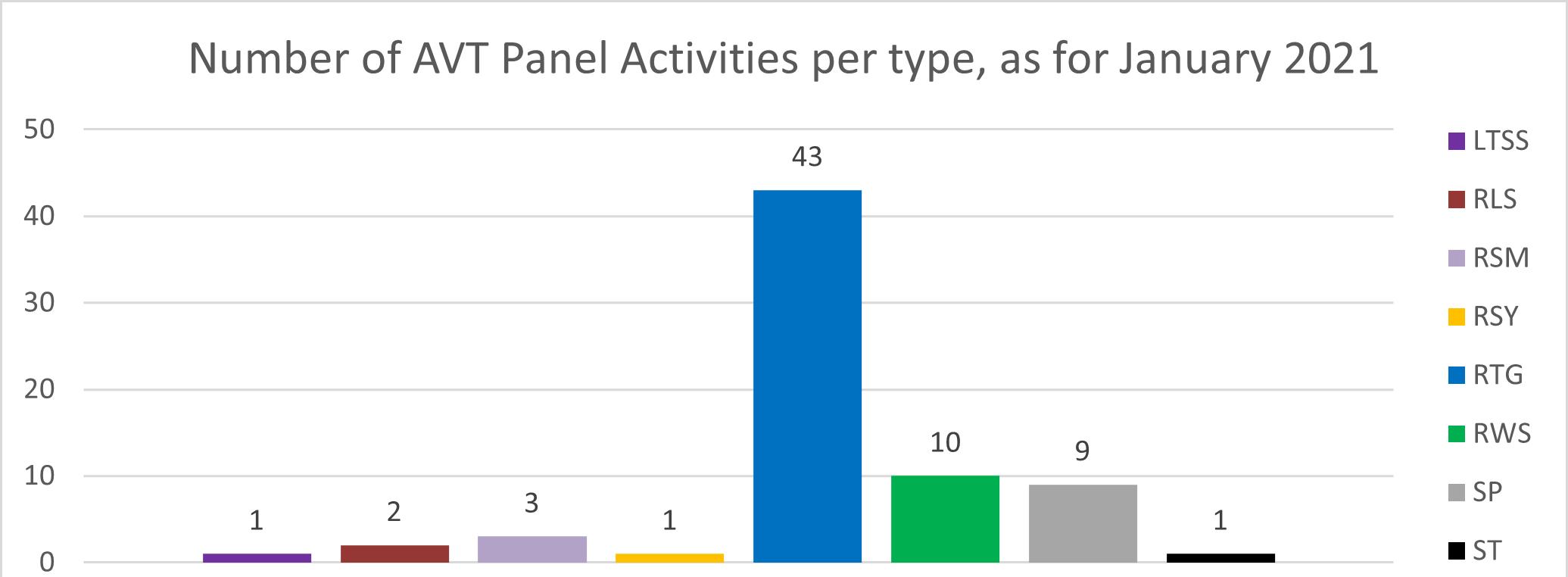


COLLABORATIVE PROGRAMME OF WORK AND BUDGET FOR YEAR 2021 13
Figure 5: Number of AVT Panel Activities per Type, as of 1 January 2021



AVT-254 RTG Assessment of Plasma Actuator Technologies for Internal Flows
AVT-255 RTG Unmanned Systems Mission Performance Potential for Autonomous Operations
AVT-291 RTG Range Design and Management for Reduced Environmental Impact
AVT-294 RTG Towards Improved Computational Tools for Electric Propulsion
AVT-359 LTSS Impact of Hypersonic Operational Threats on Military Operations and Technical High-Level Requirements
AVT-358 (VKI) RLS Advanced Computational Fluid Dynamics Methods for Hypersonic Flows
AVT-335 RSM Range Design and Management for Sustainable Live Fire Training Ranges
AVT-336 RSM Enabling Platform Technologies for Resilient Small Satellite Constellations for NATO Missions
AVT-338 RSM Advanced Wind Tunnel Boundary Simulation II
AVT-356 RSY Physics of Failure for Military Platform Critical Subsystems
AVT-290 RTG Standardization of Augmented Reality for Land Platforms in Combat Environments
AVT-292 RTG Munition Health Management Technologies: Effects on Operational Capability, Interoperability, Life-Cycle Cost and Acquisition of Missile Stockpiles of NATO Nations
AVT-293 RTG Effect of Environmental Regulation on Energetic Systems and the Management of Critical Munitions Materials and Capability
AVT-297 RTG Development of a Framework for Validation of Computational Tools for Analysis of Air and Sea Vehicles
AVT-298 RTG Reynolds Number Scaling Effects on Swept Wing Flows
AVT-300 RTG Naval Ship Maneuverability in Ice
AVT-301 RTG Flow Field Prediction for Maneuvering Underwater Vehicles
AVT-308 RTG Cooperative Demonstration of Technology (CDT) for Next-Generation NATO Reference Mobility Model (NG-NRMM)
AVT-309 RTG Implication of Synthetic Fuels on Land Systems and on NATO Single Fuel Policy
AVT-310 RTG Hybrid/Electric Aircraft Design and Standards, Research and Technology (HEADSTART)
AVT-311 RTG
Availability and Quality Issues with Raw Materials for Rocket Propulsion Systems and Potential Consequences for NATO
AVT-312 RTG Airworthiness Tools and Processes for Complex Rotorcraft Systems Safety
AVT-313 RTG Incompressible Laminar-to-Turbulent Flow Transition Study
AVT-314 RTG Assessment and Reduction of Installed Propeller and Rotor Noise from Unmanned Aircraft
AVT-315 RTG
Comparative Assessment of Modeling and Simulation Methods of Shipboard Launch and Recovery of Helicopters
14 COLLABORATIVE PROGRAMME OF WORK AND BUDGET FOR YEAR 2021 COLLABORATIVE PROGRAMME OF WORK AND BUDGET FOR YEAR 2021
ACTIVITY ACTIVITY TYPE TITLE
Table 4: AVT Activities Continuing in 2021

AVT-316 RTG Vortex Interaction Effects Relevant to Military Air Vehicle Performance
AVT-317 RTG Trade-Space Exploration to Support the Early Stage Design of Effective and Affordable (Fleets) of Warships
AVT-318 RTG Low Noise Aero-Acoustic Design for Turbofan Powered NATO Air Vehicles
AVT-319 RTG High Speed Rotorcraft Analysis and Evaluation
AVT-320 RTG Assessments of Numerical Simulation Methods for Turbulent Cavitating Flows
AVT-327 RTG Standardization Recommendation (STANREC) Development for Next Generation NATO Reference Mobility Model (NRMM)
AVT-330 RTG Impact of Underwater Dumped Munitions and Maritime Safety, Security and Sustainable Remediation
AVT-331 RTG Goal-Driven, Multi-Fidelity Approaches for Military Vehicle System-Level Design
AVT-332 RTG In-Flight Demonstration of Ice-phobic Coating and Ice Detection Sensor Technologies
AVT-333 RTG Integration of Propulsion, Power, and Thermal Subsystem Models into Air Vehicle Conceptual Design
AVT-334 RTG CDT on Augmented Reality (AR) to Enhance Situational Awareness for Armored Fighting Vehicle Crew
AVT-337 RWS Anti-Tamper Protective Systems for NATO Operations
AVT-340 RWS Preparation and Characterization of Energetic Materials
AVT-353 RWS Artificial Intelligence in Cockpits for UAVs
AVT-354 RWS Multi-Fidelity Methods for Military Vehicle Design
AVT-355 RWS Intelligent Solutions for Improved Mission Readiness of Military UxVs
AVT-357 RWS Technologies for Future Distributed Engine control Systems (DECS)
AVT-SP-001 SP
Development and Evaluation of an Advanced PACVD TiN/TiCN Coating for Military Vehicle Bearing Applications
AVT-SP-002 SP Turbulence and the Aerodynamic Optimization of Nonplanar Lifting Systems
AVT-SP-003 SP
AVT-SP-004 SP
AVT-SP-005 SP
AVT-SP-006 SP
AVT-SP-007 SP
AVT-SP-008 SP
AVT-ST-007 ST
Investigation of Sub-Idle Gas Turbine Performance
Assessment of Environmental and Toxicological Impacts Associated with Ammunition: LifeCycle Approach to Assist the REACH Regulation
Measurement of Soil Mechanical Properties Related to the Traffic-Ability of Military Vehicles on Typical Estonian Soils
Development of Simulation Model for Selecting Optimum Maintenance Strategy of Combat Vehicles
Novel Active Fire Modelling and Prediction Methods Using Manned and Unmanned Aircraft Vehicles
Determination of the Traffic-Ability of Military Vehicles in Typical Forests
Modification of NATO STANAGs to Incorporate Range Characterization

COLLABORATIVE PROGRAMME OF WORK AND BUDGET FOR YEAR 2021 15


ACTIVITY ACTIVITY TYPE
AVT-341 RTG Mobility Assessment Methods and Tools for Autonomous Military Ground Systems
AVT-342 RTG Interoperability of Additive Manufacturing in NATO operations
AVT-343 RTG Novel Materials to Mitigate Rare Earth (RE) Criticality in High Speed Motors
AVT-344 RTG Assessment of Micro Technologies for Air and Space Propulsion
AVT-345 RTG Unified Tactical Missile Kinetic Performance Model
AVT-346 RTG Predicting Hypersonic Boundary-Layer Transition on Complex Geometries
AVT-347 RTG Large-Amplitude Gust Mitigation Strategies for Rigid Wings
AVT-348 RTG Assessment of Experiments and Prediction Methods for Naval Ships Maneuvering in Waves
AVT-349 RTG Non-Equilibrium Turbulent Boundary Layers in High Reynolds Number Flow at Incompressible Conditions
AVT-350 RTG Innovative Control Effectors for Maneuvering of Air Vehicles – Advanced Concepts
AVT-351 RTG
Enhanced Computational Performance and Stability and Control Prediction for NATO Military Vehicles
AVT-352 RTG Measurement, Modeling and Prediction of Hypersonic Turbulence
AVT-360 RWS Environmentally Compliant Approaches to Maintenance and Overhaul of Military Vehicles
AVT-361 RWS Certification of Bonded Repair on Composite Aircraft Structures
AVT-364 RWS
Environmental Regulation on Energetic Systems and its Impact on Critical Munitions Materials and Capability
AVT-365 RLS Rotorcraft Flight Simulation Model Fidelity Improvement and Assessment
AVT-366 RWS Use of Computational Fluid Dynamics for Design and Analysis: Bridging the Gap Between Industry and Developers
AVT-367 RTG Sea-Ice Collision Risk Prediction and Mitigation for Naval Ships
AVT-SP-009 SP Evaluation of Hybrid Electric Propulsion Technologies for Unmanned Aerial Vehicles in Military Applications


16 COLLABORATIVE PROGRAMME OF WORK AND BUDGET FOR YEAR 2021 COLLABORATIVE PROGRAMME OF WORK AND BUDGET FOR YEAR 2021
Table 6. AVT Activities Starting in 2020
TITLE
Table 5: AVT Activities Starting in 2021

AVT-362 RTG Water Sampling, Monitoring and Control/Remediation for Live-Fire Military Ranges
AVT-363 RTG Improving the Understanding of Risks from Exposure to Munition Combustion Products


PROGRAMME OF WORK AND BUDGET FOR YEAR 2021 17
COLLABORATIVE
Table 6: AVT Activities Starting in 2022
Table 6. AVT Activities Starting in 2020 ACTIVITY ACTIVITY TYPE
TITLE
Human Factors and Medicine Panel (HFM)

Panel Chair: Ms. Alison ROGERS (GBR)
Panel Vice-Chair: Dr. Janet BLATNY (NOR)
Panel Executive: Lt. Col. Erik LAENEN (NLD)
MISSION
Panel Assistants: Ms. Marie LINET (NATO), Ms. Ezgi YAZICIOGLU (NATO) - temp.
The mission of the Human Factors and Medicine Panel is to provide the science and technology base for optimizing health, human protection, well-being and performance of the human in operational environments with consideration of affordability. This involves understanding and ensuring the physical, physiological, psychological and cognitive compatibility among military personnel, technological systems, missions, and environments. This is accomplished by exchange of information, collaborative experiments and shared field trials.
MAIN INTEREST
Combat Casualty Care: Change and innovation in Science and Technology (S&T) development in the field of combat casualty care must keep pace with advances in weapon systems and battlespace tactics, techniques, and procedures that create novel military operational environments. Current combat casualty care and medical planning guidelines are based on rapid evacuation to damage control surgery and critical care. Future operational environments will considerably affect NATO forces’ ability to adhere to these guidelines and medically evacuate casualties to provide life, limb, and eyesight saving treatments in a timely manner.
Chemical, Biological and Radiological Defence: Major changes in the security policy and the geopolitical and military situation, as well as evolving agent and weapon technologies, influence the chemical, biological, radiological and nuclear (CBRN) threat and defence. Consequently, CBRN defence requires closer collaboration between military and civilian sectors. Based on the threat out to 2030, S&T areas that can support CBRN defence need to be identified.
Human-Autonomy Teaming: Based on progress in robotics, artificial intelligence and human performance modelling, Human-Agent-Robot Teamwork (HART) systems are being developed and tested in which humans and autonomy dynamically adjust and cooperate to accomplish a joint objective, often in shared spaces. In these systems, team members’ responsibilities and commitments are managed such that the human and automation jointly enhance performance and manage contingencies.
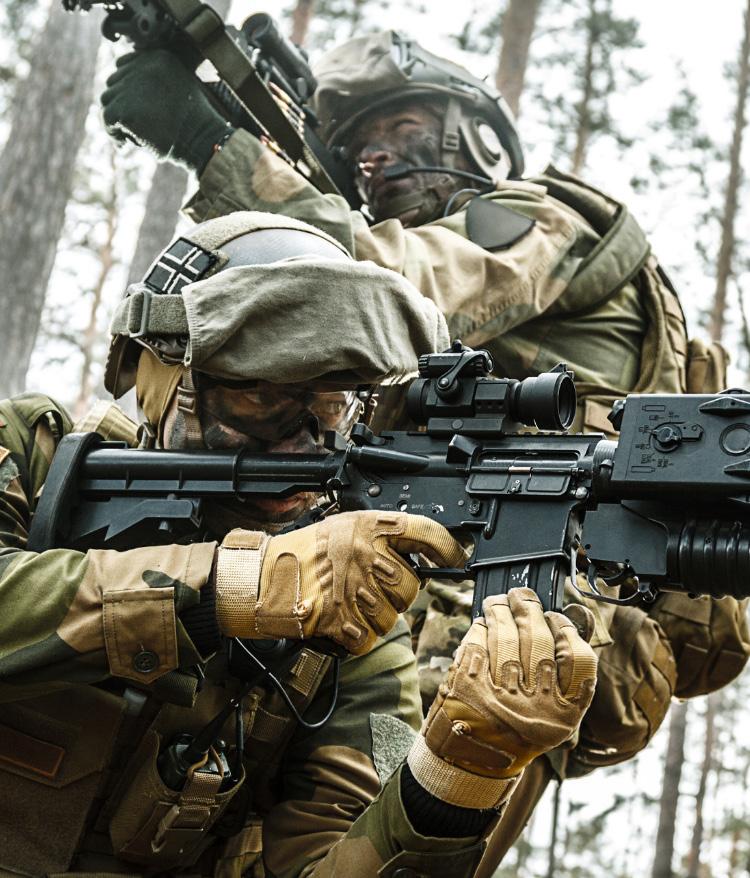



18

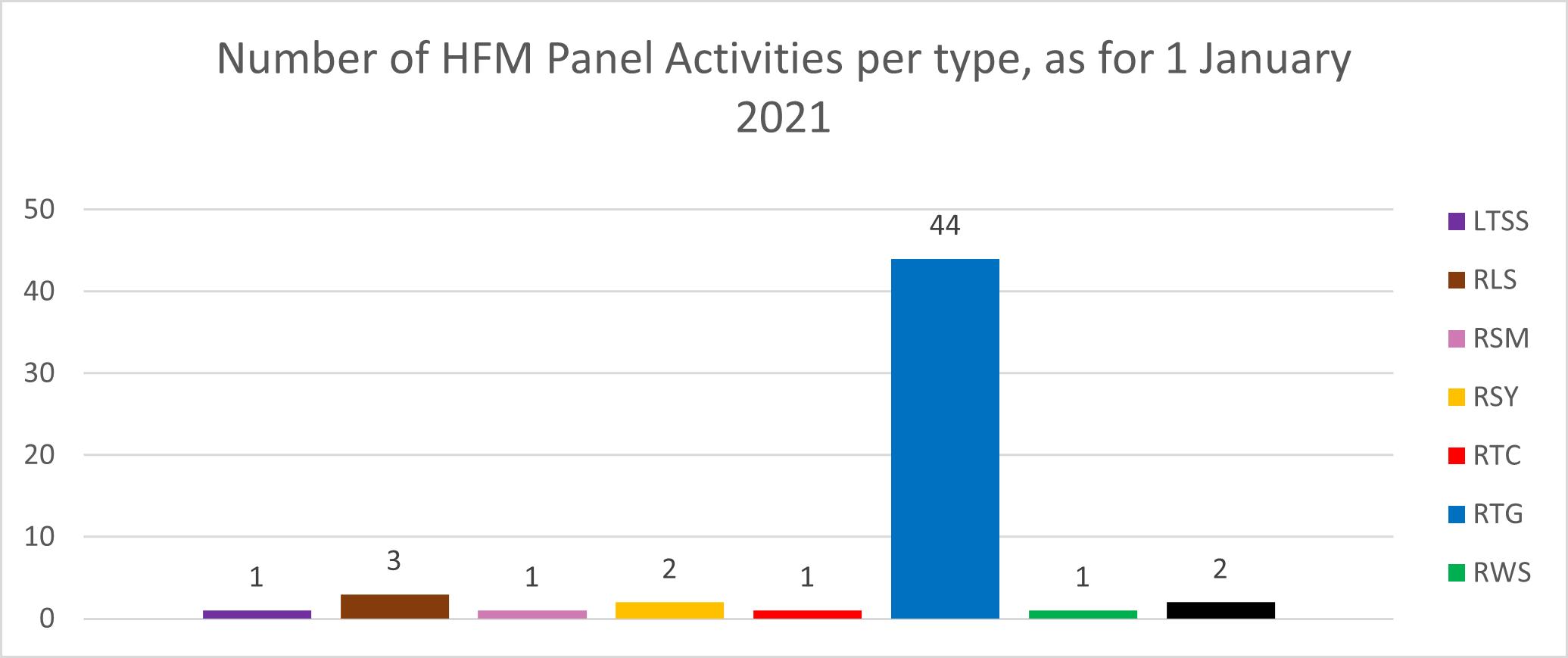


COLLABORATIVE PROGRAMME OF WORK AND BUDGET FOR YEAR 2021 19
Figure 6: Number of HFM Panel Activities per Type, as of 1 January 2021


Table 7: HFM Activities Continuing in 2021
HFM-317 LTSS Solutions for Combat Casualty Care
HFM-240 RLS Mild Traumatic Brain Injury: Post Concussive Symptoms in a Deployed Setting
HFM-314 RLS Aircrew Neck Pain Prevention and Management Lecture Series
HFM-328 RLS Collaborations between Military and Civilian Personnel in Defence Organizations
HFM-324 RSY Symposium; Solutions for Combat Casualty Care
HFM-334 RSY Applying Neuroscience to Performance: From Rehabilitation to Human Cognitive Augmentation
HFM-333 RTC Aerospace Medicine: New Technologies – New Approach RAMS USAF/NATO STO HFM
HFM-262 RTG Health Risk Assessment for Chemical Exposures of Military Interest
HFM-274 RTG The Impact of Hypobaric Exposure on Aviators and High-Altitude Special Operations Personnel
HFM-276 RTG Human Factors and ISR Concept Development and Evaluation
HFM-277 RTG Leadership Tools for Suicide Prevention
HFM-279 RTG Leveraging Technology in Military Mental Health
HFM-281 RTG Personalized Medicine in Mental Health and Performance
HFM-283 RTG Reducing Musculo-Skeletal Injuries
HFM-285 RTG Speech Understanding of English Language in Native and Non-Native Speakers/Listeners in NATO With and Without Hearing Deficits
HFM-286 RTG Leader Development for NATO Multinational Military Operations
HFM-290 RTG Advances in Military Personnel Selection
HFM-291 RTG Ionizing Radiation Bio-Effects and Countermeasures
HFM-292 RTG Understanding and Reducing Skill Decay
HFM-293 RTG Digital and Social Media Assessment for Effective Communication and Cyber Diplomacy
HFM-294 RTG Big Data In The Military: Integrating Genomics into the Pipeline of Standard-care Testing and Treatment
HFM-295 RTG Sexual Violence in Military
HFM-297 RTG Assessment of Augmentation Technologies for Improving Human Performance
HFM-298 RTG Injury Thresholds of High-Power Pulsed Radiofrequency Emissions
HFM-299 RTG Pulmonary Screening and Care in Aviators
HFM-301 RTG Military Diversity: Ethnic Tolerance and Intolerance
HFM-304 RTG Factors Impacting Ethical Leadership

20 COLLABORATIVE PROGRAMME OF WORK AND BUDGET FOR YEAR 2021 COLLABORATIVE PROGRAMME OF WORK AND BUDGET FOR YEAR 2021
ACTIVITY ACTIVITY TYPE TITLE

HFM-305 RTG Synthetic Biology in Defence: Opportunities and Threats
HFM-306 RTG Translating Medical Chemical Defence Research Into Operational Medical Capabilities Against Chemical Warfare Agent Threats
HFM-307 RTG Integrating Gender and Cultural Perspectives in Professional Military Education Programmes
HFM-308 RTG Optimizing Human Performance in NATO SOF Personnel Through Evidence-Based Mental Performance Programming
HFM-310 RTG Human Performance and Medical Treatment and Support During Cold Weather Operations
HFM-311 RTG Cognitive Neuro-Enhancement: Techniques and Technology
HFM-312 RTG Unexplained Physiologic Events in High-Performance Aircraft
HFM-313 RTG Re-Introduction of Phage Therapy in Military Medicine
HFM-316 RTG Expert Panel for State of the Art Cardiovascular Risk Assessment in Aircrew and Other High-Risk Occupations
HFM-319 RTG Measuring the Cognitive Load on the Soldier
HFM-320 RTG Fatigue Management in Aircrew
HFM-325 RTG Performance Nutrition for Fresh Feeding during Military Training and Operations
HFM-326 RTG Diet Supplementation for Military Personnel
HFM-327 RTG
Development of a NATO STANREC for Physiological Status Monitoring to Mitigate Exertional Heat Illness
HFM-329 RTG A Psychological Guide for Leaders Across the Deployment Cycle
HFM-330 RTG Human Systems Integration for Meaningful Human Control over AI-based systems
HFM-331 RTG Biomedical Bases of Mental Fatigue and Military Fatigue Countermeasures
HFM-332 RTG
Development and Implementation of Autonomous Transport and Medical Systems for Casualty Evacuation
HFM-322 RWS Meaningful Human Control of AI-based Systems: Key Characteristics, Influencing Factors and Design Considerations
HFM-337 ST COVID-19; Leadership in Volatile, Uncertain, Complex and Ambiguous world
HFM-MSG-323 ST Guidelines for Mitigating Cyber-sickness in Virtual Reality Systems


PROGRAMME OF WORK AND BUDGET FOR YEAR 2021 21
COLLABORATIVE


HFM-318 RTG Personnel Retention in the Armed Forces
HFM-338 RTG Performance Nutrition for Fresh Feeding during Military Training and Operations
HFM-341 RTG Development of a NATO STANREC for Physiological Status Monitoring to Mitigate Exertional Heat Illness
HFM-342 RTG Collaborations between Military & Civilian Personnel in Defence Organizations
HFM-343 RTG A psychological guide for leaders across the deployment cycle.
HFM-AVT-340 RTG Human Systems Integration for Meaningful Human Control over AI-based systems
HFM-SET-339 RSM Biomedical Bases of Mental Fatigue and Military Fatigue Countermeasures


22
PROGRAMME OF WORK AND BUDGET FOR YEAR 2021
PROGRAMME OF WORK AND BUDGET FOR YEAR 2021
COLLABORATIVE
COLLABORATIVE
ACTIVITY ACTIVITY TYPE TITLE
Table 8: HFM Activities Starting in 2021
Information Systems Technology Panel (IST)

PANEL Chair: Dr-Ing. Michael WUNDER (DEU)
Panel Vice-Chair: Dr. Nikolai STOIANOV, PhD (BGR)
MISSION
Act. Panel Executive: Ms. Agata SWIATKIEWICZ (NATO)
Panel Assistant: Ms. Armelle DUTRUC (NATO)
The Information Systems Technology Panel (IST) implements the STO Mission with respect to Information Systems Technology.
The mission of the IST Panel is to advance and exchange techniques and technologies in order to improve C3I systems, with a special focus on AI, Interoperability and Cyber Security, and to provide timely, affordable, dependable, secure and relevant information to war fighters, planners and strategists.
MAIN INTEREST
The Panel’s focus is the advancement and exchange of techniques and technologies to provide timely, affordable, dependable, secure and relevant information to war fighters, planners and strategists, as well as enabling technologies for modelling, simulation, and training.
IST’s scope of responsibility covers the fields of Information Warfare and Assurance, Information and Knowledge Management, Communications and Networks, and Architecture and Enabling Technologies.
The IST Programme of Work is organized under three Focus Groups:
1. Information and Knowledge Management (IWA).
2. Architecture and Intelligence Information Systems (AI2S).
3. Communications & Networks (COM).
The activities of the Panel are attached to these focus groups.
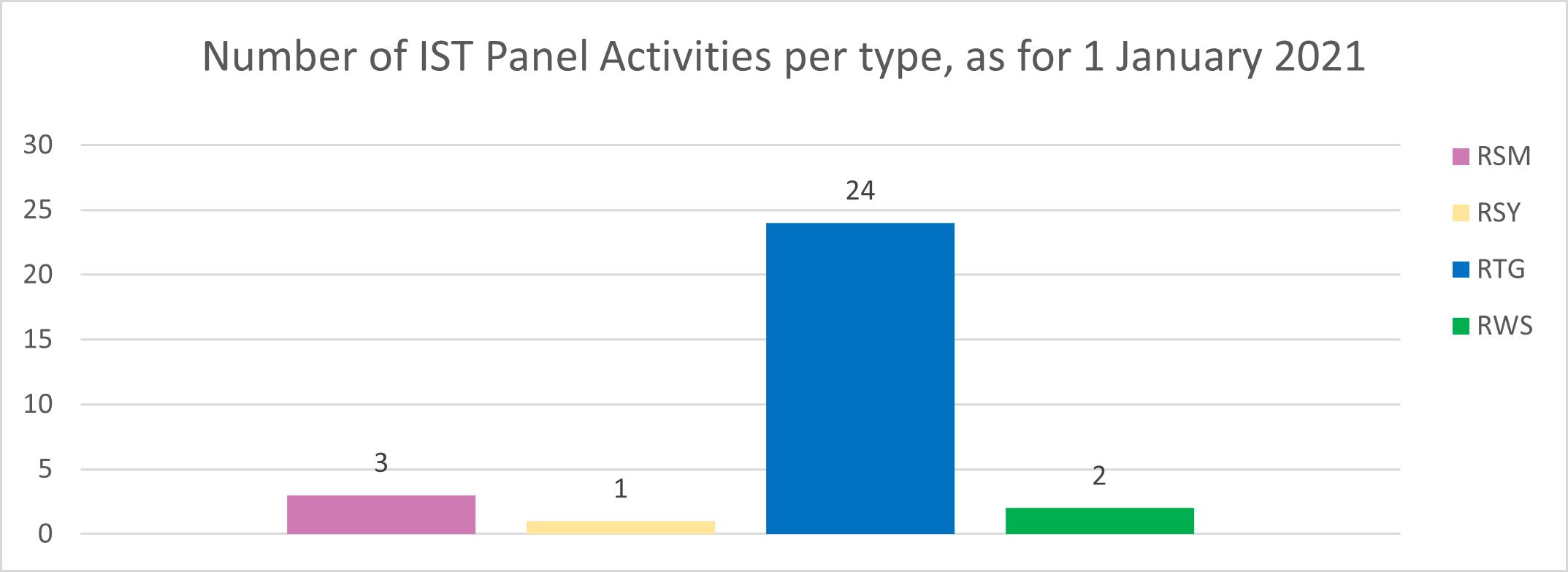

23
Figure 7: Number of IST Panel Activities per Type, as of 1 January 2021


TITLE
IST-146 RTG Electromagnetic Environment Situational Awareness for NATO
IST-152 RTG Intelligent, Autonomous and Trusted Agents for Cyber Defence and Resilience
IST-157 RTG Human in the Loop Considerations for Artificial Intelligence
IST-161 RTG Efficient Group and Information Centric Communications in Mobile Military Heterogeneous Networks
IST-163 RTG Deep Machine Learning for Cyber Defence
IST-164 RTG Securing Unmanned and Autonomous Vehicles for Mission Assurance
IST-165 RTG High-Level Fusion of Hard and Soft Information for Intelligence
IST-168 RTG Adaptive Information Processing and Distribution to Support Command and Control
IST-169 RTG Robustness and Accountability in Machine Learning Systems
IST-171 RTG FMN Cloud-Based Coalition Security Architecture
IST-172 RTG Airborne Beyond Line of Sight Communication Network
IST-174 RTG Secure Underwater Communications for Heterogeneous Network-Enabled Operations
IST-175 RTG Full Duplex Radio Technology for Military Applications
IST-176 RTG Federated Interoperability of Military C2 and IoT Systems
IST-177 RTG Social Media Exploitation for Operations in the Information Environment
IST-179 RTG Interoperability for Semi-Autonomous Unmanned Ground Vehicles
IST-180 RTG Network Management and Cyber Defence (NMCD) for Federated Mission Networking (FMN)
IST-181 RSM Terahertz-Band Communications and Networking
IST-183 RWS Deep Machine Learning for Cyber Defence
IST-184 RTG Visual Analytics for Complex Systems
IST-185 RSM Communication Networks and Information Dissemination for the Tactical Edge
IST-186 RSM Blockchain Technology for Coalition Operations
IST-187 RTG 5G Technologies Application to NATO Operations
IST-188 RTG Applying and Validating the Cyber Security Risk Assessment Process for Military Systems
IST-189 RTG Hybrid Military and Commercial SATCOM Networks
IST-HFM-182 RTG Synthetic Legal Adviser – AI-Based Decision Making in Hyperwar

24 COLLABORATIVE PROGRAMME OF WORK AND BUDGET FOR YEAR 2021 COLLABORATIVE PROGRAMME OF WORK AND BUDGET FOR YEAR 2021
Table 6. AVT Activities Starting in 2020 ACTIVITY ACTIVITY TYPE
Table 9: IST Activities Continuing in 2021
Table 6. AVT Activities Starting in 2020

IST-190 RSY AI, ML and BD for Hybrid Military Operations (AI4HMO)
IST-191 RWS Rescue Systems for Broken Trust


COLLABORATIVE PROGRAMME OF WORK AND BUDGET FOR YEAR 2021 25
Table 10: IST Activities Starting in 2021
Table 6. AVT Activities Starting in 2020 ACTIVITY ACTIVITY TYPE TITLE
NATO Modelling and Simulation Group (nMSG)

NMSG Chair: Dr. Robert SIEGFRIED (DEU)
NMSG Vice-Chair: Ms. Julie TREMBLAY-LUTTER (CAN)
MSCO Head: CDR Santiago FERNANDEZ DAPENA (ESP)
MISSION
MSCO Technical Officer: Mr. Adrian VOICULET (NATO)
MSCO Assistant: Mrs. Renata JAPERTAITE (NATO)
The NATO Modelling and Simulation Group (NMSG) is the STO Scientific and Technical Committee in which all NATO Modelling and Simulation (M&S) stakeholders and subject matter experts meet to coordinate and oversee the implementation of the NATO M&S Master Plan (NMSMP).
The NMSMP is a NAC-approved NATO policy document that provides strategic vision and guidance for coordinating and utilizing M&S in NATO. The NATO M&S vision is “to exploit M&S to its full potential across NATO and the Nations to enhance both operational and cost effectiveness”
The mission of the NMSG is to promote cooperation among Alliance bodies, NATO, and partner nations to maximize the effective utilization of M&S. This includes M&S standardization, education, and associated science and technology. The NMSG, as nominated by the Conference of National Armaments Directors (CNAD), is the delegated tasking authority for standardization in the NATO modelling and simulation domain.
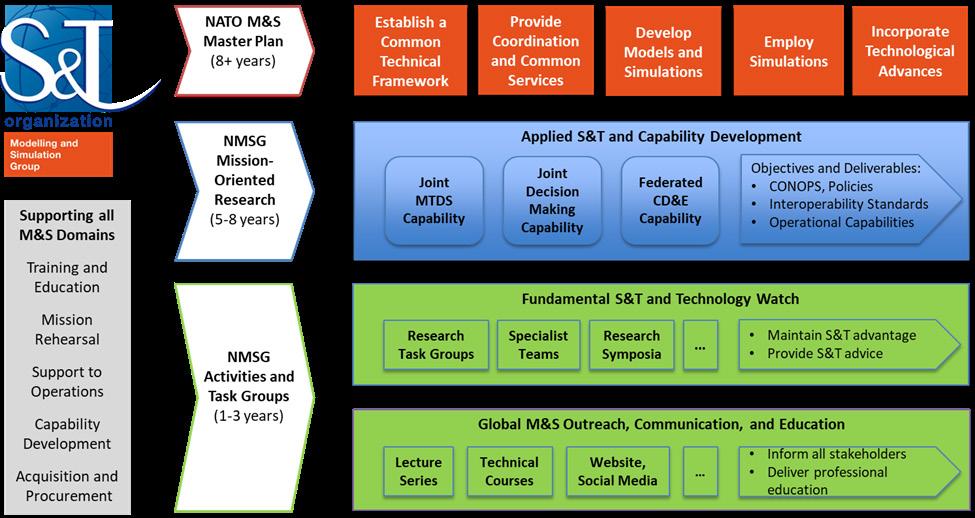

26
Figure 8: NMSG Mission-Oriented Research

MAIN INTEREST
The NMSMP articulates the NATO vision and guiding principles regarding the use of M&S in support of the NATO mission, discusses the impact that achieving this vision will have on NATO M&S application areas and identifies the governance mechanisms and bodies, and the primary NATO M&S stakeholders.
Under the umbrella of establishing a common technical framework, increasing interoperability and developing models, simulations and standards for M&S, the main current and future focus areas of work are: education and training; decision making; AI & BD; cyber defence; and acquisition.
With the mission to investigate, plan, update and propose the future Programs of Work, the NMSG has three permanent sub-groups: the Military Operational Requirements Subgroup; the M&S Standards Subgroup; and the Planning and Programmes Committee.
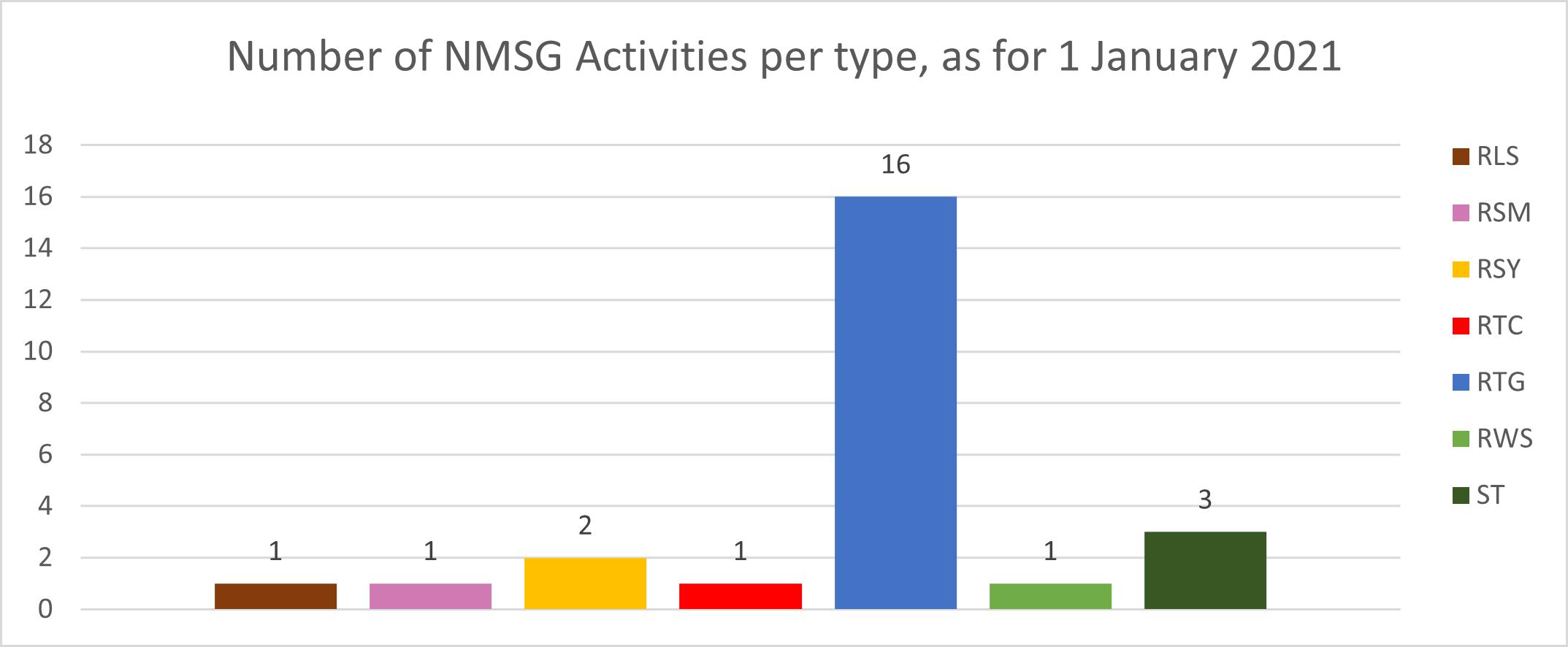
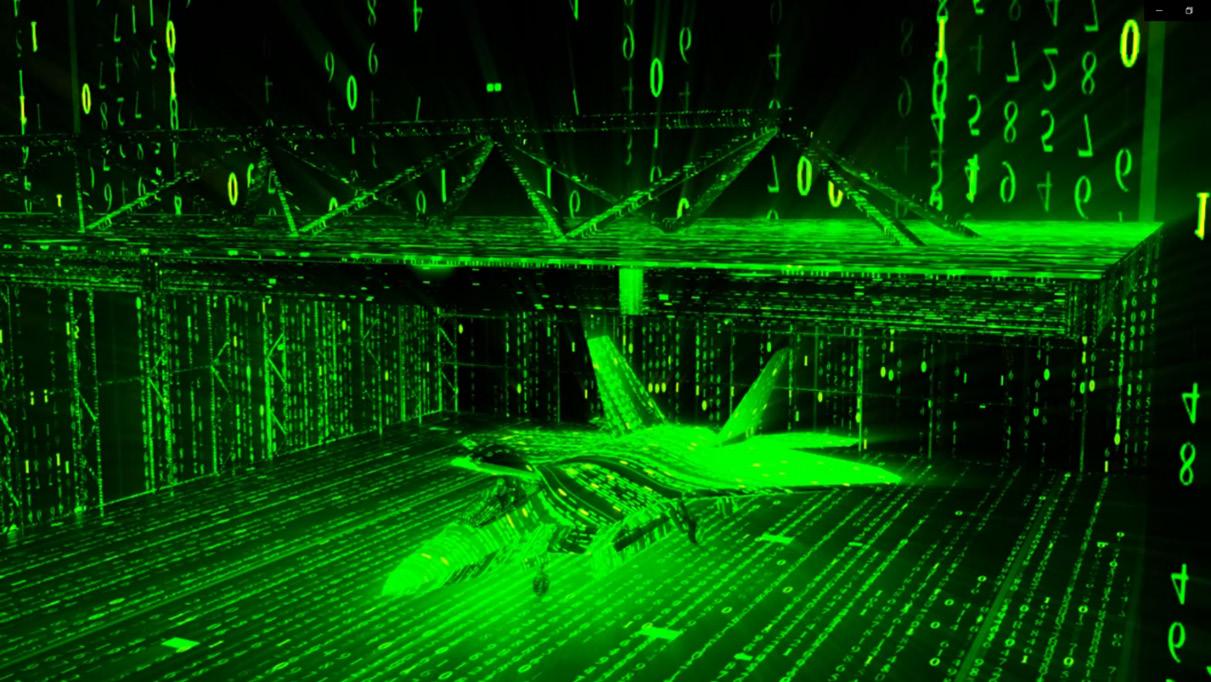

COLLABORATIVE PROGRAMME OF WORK AND BUDGET FOR YEAR 2021 27
Figure 9: Number of NMSG Activities per Type, as of 1 January 2021


MSG-154 RTG Low Slow Small Threats Modelling and Simulation
MSG-157 RTG NATO M&S Resources/Standards Support Team – II
MSG-163 RTG Evolution of NATO Standards for Federated Simulation
MSG-164 RTG Modelling and Simulation as a Service – Phase 2
MSG-165 RTG Incremental Implementation of Mission Training through Distributed Simulation for Joint and Combined Air Operations
MSG-168 RLS Modelling and Simulation as a Service (MSaaS)
MSG-172 RTG NATO Modelling and Simulation Master Plan Implementation Update
MSG-173 RTG Simulation for Training and Operation Group – Next Generation (STOG-NG)
MSG-SAS-178 RTG Using Simulation to Better Inform Decision Making for Warfare Development, Planning, Operations and Assessment
MSG-174 RTG Urban Combat Advanced Training Technology Live Simulation Standards (UCATT-LSS) – 2
MSG-179 RTG Modelling and Simulation for Acquisition
MSG-180 RTG Implementation of Live Virtual Constructive – Training (LVC-T) in the Maritime Domain
MSG-181 RTG Physics-Based Electro-Optic/Infrared Simulations – Best Practice Recommendations for Decision Support
MSG-SET-183 RSM Drone Detectability: Modelling the Relevant Signature
MSG-185 RSY MSG/MSCO Support to International Training and Education Conferences IT2EC, I/ITSEC and CA2X2 Forum 2021
MSG-187 RTG Space Weather Environmental Modelling (SWEM)
MSG-188 ST Modelling and Simulation of Effects of Cyber Attacks
MSG-189 ST AI Augmented Immersive Simulation in Training and Decision-Making Course of Actions Analysis
ACTIVITY ACTIVITY TYPE TITLE
MSG-184 RSY Towards Training and Decision Support for Complex Multi-Domain Operations
MSG-186 RTG Multi-Dimensional Data Farming
MSG-190 RTG NATO M&S Professional Certification
MSG-191 RTG NATO Standards for Federated Simulation and Services for Integration, Verification and Certification
MSG-192 RWS Commercial Technologies and Games for Use in NATO and Nations
MSG-193 ST Modelling and Simulation Standards in Federated Mission Networking (FMN)
MSG-194 RTC Employing the C2-Simulation Interoperation (C2SIM) Standard for Coalition Military Operations and Exercises

28 COLLABORATIVE PROGRAMME OF WORK AND BUDGET FOR YEAR 2021 COLLABORATIVE PROGRAMME OF WORK AND BUDGET FOR YEAR 2021
Table 11: NMSG Activities Continuing in 2021
ACTIVITY ACTIVITY
Table 6. AVT Activities Starting in 2020
TYPE TITLE
Table 12: NMSG Activities Starting in 2021
Table 6. AVT Activities Starting in 2020
System Analysis and Studies Panel (SAS)

Panel Chair: Mr. Espen SKJELLAND (NOR)
Panel Vice-Chair: Mrs. Donna WOOD (CAN)
MISSION
Panel Executive: LTC Timothy POVICH, PhD (USA)
Panel Assistant: Mr. Jeroen GROENEVELT (NATO)
The System Analysis and Studies (SAS) Panel – NATO STO’s expert panel for analytical advice – conducts studies and analysis for better decisions in strategy, capability development, and operations within NATO, NATO Nations, and partner Nations. Key drivers in the SAS Panel’s work are the exploitation of new technologies, new forms of organization, and new concepts of operation.
Currently, the SAS Panel consists of 43 senior scientific representatives from 23 NATO Nations, 2 Partnership for Peace Nations, 1 Global Partner, and 4 NATO organizations. The SAS Panel leverages analysts and scientists from academia, government, and industry to conduct research.
MAIN INTEREST
The focus of the Panel is on undertaking Operations Analysis activities related to challenges in the evolving strategic environment and the responses that both individual nations and NATO as a whole are making to tackle them. The research can be clustered into 4 focus areas: Policy and Strategy Decision Support; Operations Decision Support; Capability and Investment Decision Support; and Development and Maintenance of Analysis Capabilities.
The development and maintenance of analysis capabilities forms the basis of the Panel work and is essential to providing NATO with innovative and academically sound analytical capabilities that will ensure informed defence decision making. Activities include the development of analytical methods to address upcoming security challenges; information exchange on OA modelling concepts and best practice; research into new methodological approaches; and the development and exchange of models.
The Panel leverages its broad range of analysis capabilities to provide decision support at all levels and in different areas. To illustrate, the Panel identifies and assesses the impacts of geo-political drivers; regional contexts; futures; and technology changes to support policy and strategy decisions. The Panel conducts analysis to improve operational tactics, training and procedures. In addition, the Panel develops better methods to support operational planning. Finally, the Panel supports the development of systems, force element and enabler capability options, including the collection and collation of cost and performance data and defining the necessary missions for these individual systems and capabilities.
The main source for new research projects is proposals made by NATO Nations represented on the SAS Panel. The SAS Panel also addresses requests for such analysis and studies from a variety of other sources. These include the Science and Technology Board (STB) and other NATO bodies, such as the NATO Military Committee; the Conference of National Armament Directors (CNAD) with its Main Armaments Groups; the NATO Industrial Advisory Group (NIAG); Allied Command Operations (ACO); Allied Command Transformation (ACT); and the NATO Communications and Information Agency (NCIA).


29


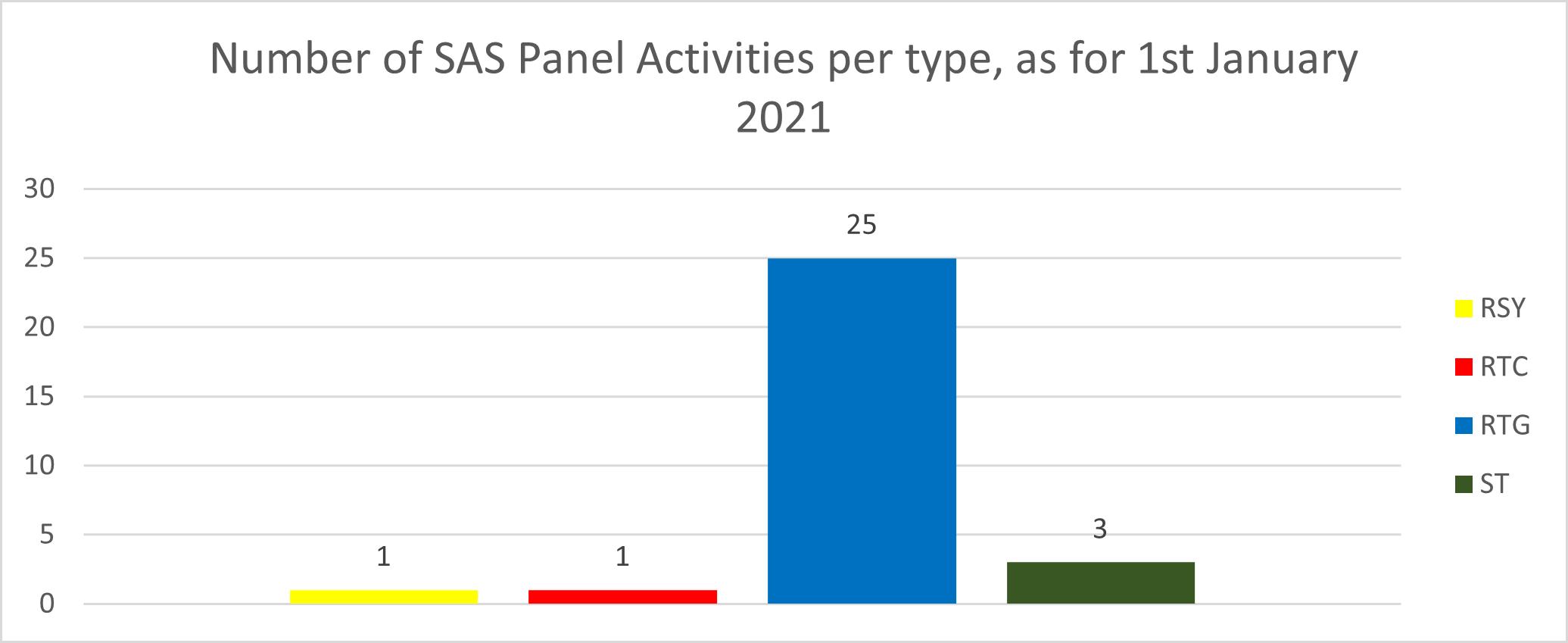


30 COLLABORATIVE PROGRAMME OF WORK AND BUDGET FOR YEAR 2021
PROGRAMME OF WORK AND BUDGET FOR YEAR 2021
COLLABORATIVE
Figure 10: Number of SAS Panel Activities per Type, as 1 January 2021

SAS-124 RTG Visualization Design for Communicating Defence Investment Uncertainty and Risk
SAS-129 RTG Gamification of Cyber Defence/Resilience
SAS-134 RTG Linking Strategic Investments and Divestments to Defence Outcomes
SAS-136 RTG Optimization of Investment in Simulation-Based Military Training
SAS-139 RTG NATO Analytical War Gaming – Innovative Approaches for Data Capture, Analysis and Exploitation
SAS-140 RTG Directed Energy Weapons Concepts and Employment
SAS-143 RTG Agile, Multi-Domain C2 of Socio-Technical Organizations in Complex Endeavors
SAS-144 RTG Code of Best Practice for Conducting Survey Research in a Military Context
SAS-145 RTG SWEAT (Soldier System Weapon and Equipment Assessment Tool)
SAS-147 RTG Analysis of Anti-Access Area Denial (A2/AD)
SAS-149 RTC Basics of Complex Modern Urban Functions and Characteristics
SAS-150 ST Advanced Analytics and Artificial Intelligence for Defence Enterprise Resource Planning
SAS-151 RTG Solutions Enabling Intermediate Force / Non-Lethal Weapon Contributions to Mission Success
SAS-152 RTG Conceptual Framework for Comprehensive National Defence System
SAS-153 RTG Best Practices on Cost Analysis of Information and Communication Technology
SAS-154 RTG Future Strategic Environment Assessment: Framework for Analysis
SAS-155 ST Providing OR&A Model Sharing Guidance to the Alliance
SAS-156 RTG Developing a Standard Methodology for Assessing Multinational Interoperability
SAS-157 RTG Automation in the Intelligence Cycle
SAS-158 RTG Employing AI to Federate Sensors in Joint Settings
SAS-159 RTG How Could Technology Development Transform the Future Operational Environment
SAS-160 RTG Ethical, Legal and Moral (ELM) Impacts of Novel Technologies on NATO’s Operational Advantage – The “ELM Tree”
SAS-161 RTG Military Aspects of Countering Hybrid Warfare: Experiences, Lessons, Best Practices
SAS-163 RTG Energy Security in the Era of Hybrid Warfare
SAS-164 RTG 21st Century Force Development
SAS-165 RSY Assessing the Implications of Emerging Technologies for Military Logistics

COLLABORATIVE PROGRAMME OF WORK AND BUDGET FOR YEAR 2021 31
TITLE
Table 6. AVT Activities Starting in 2020 ACTIVITY ACTIVITY TYPE
Table 13: SAS Activities Continuing in 2021


COLLABORATIVE PROGRAMME OF WORK AND
COLLABORATIVE PROGRAMME OF WORK AND
FOR YEAR 2021
FOR YEAR 2021
SAS-166 RTG Wargaming Multi-Domain Operations in an A2/AD Environment
SAS-167 RTG Assessing the Value of Cyber Operations in Military Operations
SAS-168 RTG Coalition Sustainment Interoperability Study
SAS-IST-162 ST A Hackathon to Determine How Large Exercise Datasets can be Used to Reconstruct Operational Decision Making to Improve Training and Analysis value


32
BUDGET
BUDGET
Systems Concepts and Integration Panel (Sci)

Panel Chair: Dr. Karin STEIN (DEU)
Panel Vice-Chair: Mr. Allan CHAN (USA)
MISSION
Panel Executive: Lt. Col. Roderick BENNETT (USA)
Panel Assistant: Ms. Carlotta ROSSI (NATO)
The mission of the Systems, Concepts and Integration (SCI) Panel is to advance knowledge concerning advanced system concepts, integration, engineering techniques and technologies across the spectrum of platforms and operating environments to assure cost-effective mission area capabilities. Integrated defence systems, including air, land, sea, and space systems (manned and unmanned), and associated weapon and countermeasure integration are covered. The SCI Panel’s activities focus on NATO and national mid to long-term system level operational needs.
MAIN INTEREST
The scope of Panel activities covers a multidisciplinary range of theoretical concepts, design, development, and evaluation methods applied to integrated defence systems. Areas of interest include:
• Integrated mission systems including weapons and countermeasures.
• System architecture/mechanization.
• Vehicle integration.
• Mission management.
• System engineering technologies and testing.
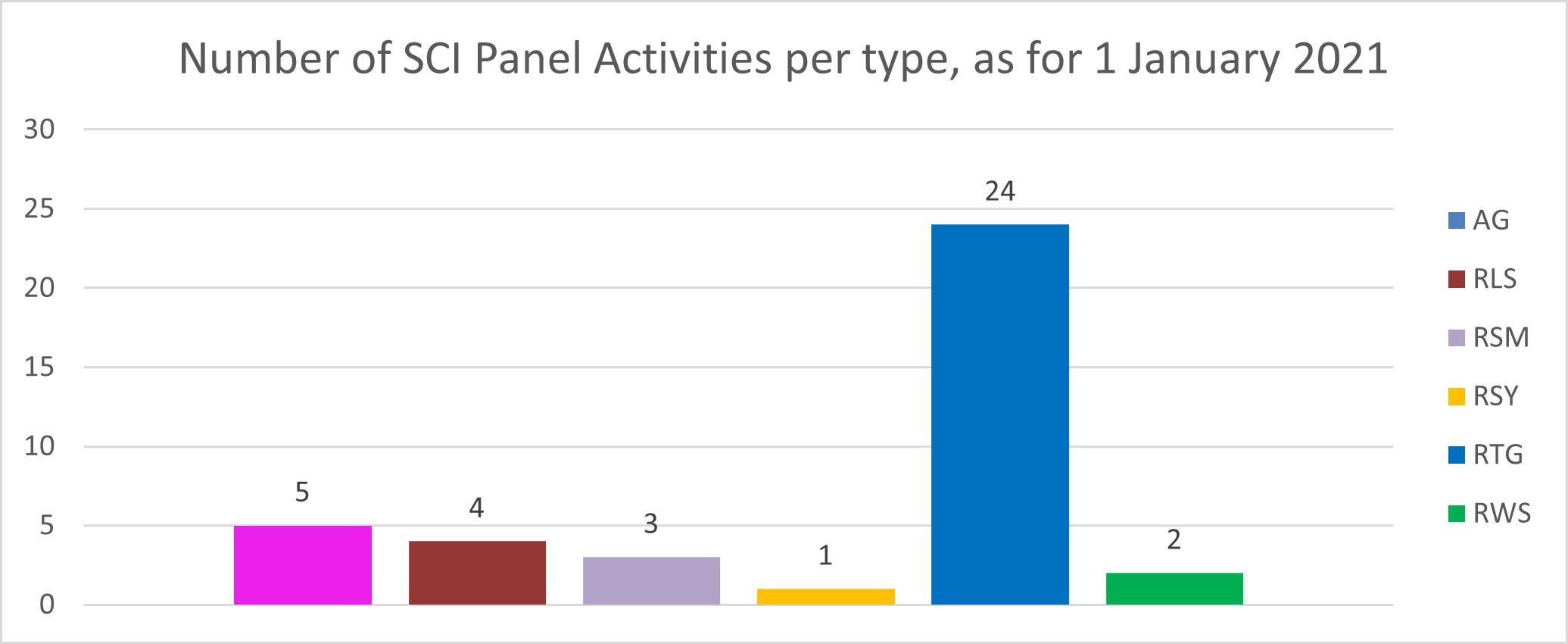

33
Figure 11: Number of SCI Panel Activities per Type, as of 1 January 2021



SCI-277 RLS Store Separation and Trajectory Prediction
SCI-298 RTG Identification and Neutralization Methods and Technologies for C-IED
SCI-301 RTG Defeat of Low Slow and Small (LSS) Air Threats
SCI-302 RTG DIRCM Concepts and Performances
SCI-303 AG
AG-300 V.33 Flight Test Techniques for the Assessment of Fixed-Wing Aircraft Handling Qualities
SCI-304 RTG Optimized and Reconfigurable Antennas for Future Vehicle Electronic Counter Measures
SET-305 COM Flight Test Technical Team (FT3)
SCI-306 AG
AG-300 V.34 Reduced Friction Runway Surface Flight Testing: Issue 2
SCI-307 RTG FAMOS Framework for Avionics Mission Systems
SCI-310 RTG Expanded Countermeasure Methods Against IR Anti-Ship Threats in Varied Parameter and Scenario Engagements Using All-Digital Tools Sets
SCI-311 RTG Collaborative Space Domain Awareness Data Collection and Fusion Experiment
SCI-312 RTG EO-IR Countermeasures
SCI-314 AG
AG-300 V.35 Ground and Flight Test Methods Used to Assure Aero-Elastic Stability of Fixed Wing Aircraft
SCI-315 AG AG-300 V.36 Flight Testing of Helmet Mounted Displays
SCI-316 RTG High Energy Laser Weapons: Quantifying the Impact of Atmospherics and Reflections
SCI-317 RLS Hands-On with JANUS: Understanding, Implementing and Using the First Digital Underwater Communications Standard
SCI-320 RTG Scientific Support to NNAG Above Water Warfare Capability Group
SCI-321 RTG UAV Applications for Military Search
SCI-322 RTG Scientific Support to NATO Aerospace Capability Group 3 Sub-Group 2 (ACG3/SG2) on Suppression of Enemy Air Defence (SEAD)
SCI-324 RWS Realization and Evaluation of Robotic Multispectral Decoys for Land Equipment
SCI-325 RTG Methods of Identifying and Evaluation the Camouflage and Deceptive Properties of the Military Equipment in Land Field Trials
SCI-326 RTG Electronic Support (ES) Techniques Enabling Cognitive Electronic Warfare (EW)
SCI-327 RTG Countermeasure Concepts Against Anti-Aircraft Dual Band EO/IR Imaging Seekers
SCI-329 RSM Capabilities for Sensing, Search, and Surveillance in the Arctic
SCI-330 RLS Multinational Capability Development Campaign (MCDC) Analysis on Autonomous Unmanned Systems (UAxS)
SCI-332 RTG Radio Frequency-Based Electronic Attack to Modern Radar
SCI-333 RTG Multi-sensor Fusion Architecture for the Detection of Person-Borne-Improvised Explosive Devices (PB-IEDs)
SCI-334 RTG Evaluation of Swarm System for Military Applications
34 COLLABORATIVE PROGRAMME OF WORK AND BUDGET FOR YEAR 2021 COLLABORATIVE PROGRAMME OF WORK AND BUDGET FOR YEAR 2021
Table 14: SCI Activities Continuing in 2021
TITLE
Table 6. AVT Activities Starting in 2020
ACTIVITY ACTIVITY TYPE

SCI-335 RSM Autonomy from a System Perspective – Version 2.0
SCI-337 RWS Combination of Field Measurements and M&S Assessment Methods
SCI-338 AG AG-300-V.37 Flight Testing of Unmanned Aerial Vehicles
SCI-340 RLS HEL Weapon Technology, Opportunities, and Challenges
SCI-342 RTG Explosive Ordnance Disposal (EOD) Tele-Manipulation Robot Technology Roadmap Development
SCI-SET-323 RSM Above Water EO/IR Signature Requirements from an Operational Perspective
in 2021
2020 ACTIVITY ACTIVITY TYPE TITLE
SCI-336 RTG Cyber-Physical Systems Resilience for NATO Operations
SCI-341 RSY Situation Awareness of Swarms and Autonomous Systems
SCI-343 RTG Enabling Federated, Collaborative Autonomy
SCI-344 RTG Future Multi-sensor Threat Defeat Concepts
SCI-346 RTG Space Risk Assessment Matrix (S-RAM)
SCI-347 RTG SMART IED Threat Mitigation Technology Assessments SMiTMiTA
TITLE
SCI-328 RSY Flight Testing of Unmanned Aerial Systems (UAS)
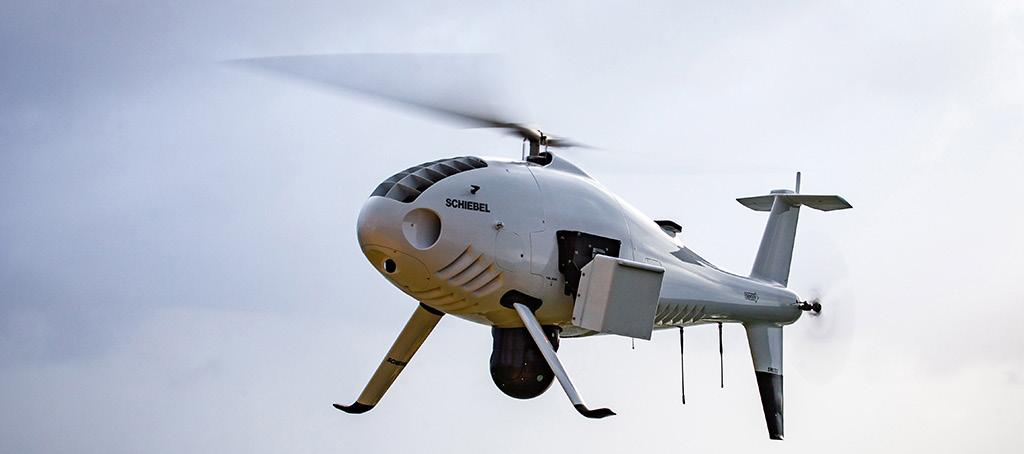

COLLABORATIVE PROGRAMME OF WORK AND BUDGET FOR YEAR 2021 35
Table 15: SCI Activities Starting
Table 6. AVT Activities Starting in
Table 16: SCI Activities Starting in 2022
Table 6. AVT Activities Starting in 2020 ACTIVITY ACTIVITY TYPE
Sensors and Electronics Technology Panel (Set)

Panel Chair: Mr. Frank VAN DEN BOGAART (NLD)
Panel Vice-Chair: Dr. Alexandre JOUAN (CAN)
MISSION
Panel Executive: Lt. Col. Isidoro MARCONE (ITA)
Panel Assistant: Ms. Illeana GANZ (NATO)
The mission of the Sensors and Electronics Technology (SET) Panel is to foster co-operative research, the exchange of information, and the advancement of science and technology among the NATO Nations in the field of sensors and electronics for defence and security. The SET Panel addresses the development and enhancement of both passive and active sensors, as well as electronic technology capabilities, multi sensor integration and fusion as they pertain to Intelligence, Surveillance, Target Acquisition and Reconnaissance (ISTAR), Remote Sensing, Electronic Warfare (EW), Communications, and Navigation. To fulfil this mission, the SET Panel is organized into three Focus Groups: RadioFrequency Technology (RFT); Optical Technology (OT); and Multi-Sensors & Electronics (MSE).
MAIN INTEREST
The research activities of the SET Panel predominantly address topics related to target signatures, propagation and battlespace environments, sensors (e.g., Electro-Optic (EO), Radio-Frequency (RF), acoustic/magnetic), antennas, signal and image processing, components, sensor hardening, electromagnetic compatibility and any other phenomena associated with sensors and electronics that may assist NATO war-fighters during future warfare and peace-keeping scenarios.
In principle, the Focus Groups address the following domains:
1. Multi Sensors and Electronics:
• Sensing for ISR;
• C-IED;
• Swarms;
• Navigation.
2. Radio Frequency Technology:
• Radar (including Active, Passive, SAR, Noise, Cognitive, Multi-and Bistatic, Multi-function, SW Defined);
• ATR/NCTR;
• Radar Imaging;
• Radar Signatures;
• Spectrum Management.
3. Optical Technology:
• Infrared and Spectral Sensing;
• Laser Radar Technology;
• Performance Modeling;
• Target Signatures.


36
Figure 12: Number of SET Panel Activities per Type, as of 1 January 2021

Table 6. AVT Activities Starting in 2020
SET-217 RTG Assessing and Modeling the Performance of Digital Night Vision Image Fusion
SET-242 RTG Passive Coherent Locators on Mobile Platforms
SET-246 RTG Short Wave Infrared Technology: A Standardized Irradiance Measurement and Compatibility Model to Evaluate Reflective Band Systems
SET-249 RTG Laser Eye Dazzle Threat Evaluation and Impact on Human Performance
SET-250 RTG Multi-Dimensional Radar Imaging
SET-252 RTG Development of a Validation Model of a Stealth UCAV
SET-256 RTG Interoperability and Networking of Disparate Sensors and Platforms for ISR Applications
SET-257 RLS Compressive Sensing Techniques for Radar and ESM Applications
SET-258 RTG DMPAR Deployment and Assessment in Military Scenario
SET-260 RTG Assessment of EO/IR Technologies for Detection of Small UAVs in an Urban Environment
SET-263 RTG Swarms Systems for Intelligence Surveillance and Reconnaissance
SET-266 RTG Multi-Functional EO/IR Sensors for Counter-Surveillance
SET-268 RTG Bi-/Multi-Static Radar Performance Evaluation Under Synchronized Conditions
SET-269 RTG EO/IR Ship Signature Dynamics
SET-270 RTG Overcoming the Technical Barriers that Inhibit Use of Fuel Cells for Dismounted Soldier Applications
SET-271 RTG Airborne Maritime Radar Based Submarine Periscope Detection and Discrimination at High Grazing Angles
SET-272 RTG Automated Scene Understanding for Battlefield Awareness
SET-273 RSM Multidimensional Radar Imaging and ATR
SET-274 RLS Cooperative Navigation in GNSS Degraded and Denied Environments
SET-278 RTG Machine Learning for Wide Area Surveillance
SET-279 RTG Space-Based SAR and Big Data Technologies to Support NATO Operations
SET-280 RTG Phenomenology and Exploitation of CMs
SET-283 RTG Advanced Machine Learning ATR using SAR/ISAR Data
SET-284 RSM Enhanced Situation Awareness Using Active-Passive Radar Systems in Military Scenarios
SET-285 RTG Multifunction RF Systems
SET-286 RTG Acoustic and Seismic Sensing of Threats in Urban Environments
SET-287
SET-288
RTG Characterization of Noise Radar
RTG Integrating Compressive Sensing and Machine Learning Techniques for Radar Applications
SET-289 RWS Nanotechnology for Optics and Infrared Photo Detection
SET-291 RTG Sensitivity of EO TDAs to Environmental Factors
SET-292 RTG Enhanced Raman Spectroscopy for Defence Applications

COLLABORATIVE PROGRAMME OF WORK AND BUDGET FOR YEAR 2021 37
Table 17: SET Activities Continuing in 2021
ACTIVITY
ACTIVITY TYPE TITLE


SET-293
RTG RF Sensing for Space Situational Awareness
SET-294 RTG Advanced Mid-Infrared Laser Technology
SET-295 RTG Radar Signature Measurements of Maritime Platforms
SET-301 RTG SimPL Simulation of Low Photon Lidar
SET-303 RTG Military Applications of Extreme Laser Fields
ACTIVITY ACTIVITY TYPE
SET-276
TITLE
ST Quality Assurance and Assessment Team for SPS on DEXTER (Detection of Explosives and Firearms to Counter TERrorism)
SET-290 RLS AI for Military ISR Decision Makers
SET-296 RTG Radar Against Hypersonic Threats
SET-298 RSM Electronic Attack and Protection for Modern Active/Passive Netted Radars
SET-299 RLS Passive Radars – Technology and Applications
SET-300 RTG 3D Active and Passive EO/IR Sensing for Urban Operations
SET-302 RTG Cognitive Radar
SET-304 RTG Modeling, Measuring and Mitigating Optical Turbulence: M3T
SET-305 RTG Improved Field of View for Night Vision Goggles – Technical Challenges, Concepts, Performance Assessment
SET-306 RTG
Improved Panoramic Situational Awareness for Vehicle Platforms – Technical Challenges, Concepts, Performance Assessment


38 COLLABORATIVE PROGRAMME OF WORK AND BUDGET FOR YEAR 2021 COLLABORATIVE PROGRAMME OF WORK AND BUDGET FOR YEAR 2021
Table 18: SET Activities Starting in 2021
Table 6. AVT Activities Starting in 2020
STO Events in 2021 CPoW

Among various activities administered by the Collaboration Support Office there are several that represent different types of events. These are: Lecture Series, Technical Courses, Symposia, Workshops and Specialists’ Meetings.


39
Visit our website at: www.sto.nato.int to learn about STO Events we organize.


Lecture Series in 2021
A Research Lecture Series (RLS) technical team activity aims to disseminate state-of-the-art scientific knowledge among junior and mid-level specialists, scientists and engineers in military-relevant domains that are not taught in universities. An RLS is a two-day educational event that is normally organized at three different locations. RLSs can include a roundtable discussion. RLSs are combined with an STO publication (Educational Notes), which will be made available before the first RLS session.
SCI-317
SCI-330 RLS
Hands-On with
Implementing and Using the First Digital Underwater Communications Standard TBC Virtual UU (participation NATO + PfP + MD)
Multinational Capability Development Campaign (MCDC) Analysis on Autonomous Unmanned Systems (UAxS) TBC TBC UU (however, participation only NATO + AUS, FIN, SWE + CHE)
SCI-340 RLS HEL Weapon Technology, Opportunities, and Challenges TBC TBC NU (NATO + AUS, FIN, SWE)
SET-257 RLS Compressive Sensing Techniques for Radar and ESM Applications Jun TBD

SET-274 RLS
Cooperative Navigation in GNSS Degraded and Denied Environments TBD
Ottawa, CAN Naples, ITA Warsaw, POL NU (NATO + EOPs + PfP)
Dayton USA Linkoping, SWE Zagreb, HRV UU (NATO + EOPs + PfP + SGP)
40 COLLABORATIVE PROGRAMME OF WORK AND BUDGET FOR YEAR 2021 COLLABORATIVE PROGRAMME OF WORK AND BUDGET FOR YEAR 2021 ACTIVITY ACTIVITY TYPE TITLE MEETING DATE MEETING LOCATIONS DISTRIBUTION AND PARTNER PARTICIPATION AVT-358 (VKI) RLS Advanced Computational Fluid Dynamics Methods for Hypersonic Flows TBD TBD UU AVT-365 RLS Rotorcraft Flight Simulation Model Fidelity Improvement and Assessment Mar 2021 TBD UU (NATO + EOP) HFM-240 RLS
Traumatic Brain Injury: Post Concussive Symptoms in a Deployed Setting Fall Tbilisi, GEO UU (NATO + PfP + MD + GP) HFM-314 RLS Aircrew Neck Pain Prevention and Management Lecture Series Fall/Winter GBR-BEL-USA UU HFM-328 RLS Collaborations Between Military and Civilian Personnel in Defence Organizations Fall/Winter USA-SWE-BEL UU MSG-168 RLS Modelling and Simulation as a Service (MSaaS) 28 – 30 Apr Virtual Meeting UU (EOP, PfP, ICI, GP, SGP, Other) SCI-277 RLS Store Separation and Trajectory Prediction 1 week of Jun Virtual UU (participation only NATO + AUS, FIN, SWE)
Mild
RLS
JANUS: Understanding,
Table 19: Lecture Series

Wachtberg, DEU
Varna, BGR Budapest, HUN, Atlanta USA
Technical Courses in 2021
(NATO + EOPs + PfP)
A Research Technical Course (RTC) is an educational technical team activity aimed at transferring practical knowledge and recent field developments through on-site instructor training or lectures to military decision makers.


COLLABORATIVE PROGRAMME OF WORK AND BUDGET FOR YEAR 2021 41
ACTIVITY ACTIVITY TYPE TITLE MEETING DATE MEETING LOCATIONS DISTRIBUTION AND PARTNER PARTICIPATION HFM-333 RTC Aerospace Medicine: New Technologies – New Approach RAMS USAF/NATO STO HFM 22 – 23 Jun Virtual Meeting UU (NATO + EOP) MSG-194 RTC Employing the C2-Simulation Interoperation (C2SIM) Standard for Coalition Military Operations and Exercises 24 – 25 Feb 4 – 8 Oct Online; possible hybrid – Orlando, USA UU (NATO + EOP, PfP, GP) SAS-149 RTC Basics of Complex Modern Urban Functions and Characteristics Jun 2021 Rome, ITA NU (NATO + PfP, AUS, NZL)
RLS AI for Military ISR Decision Makers Oct – Nov TBD
Table 20: Technical Courses
SET-290
Rome,
NU (NATO
SET-299 RLS Passive Radars – Technology and Applications QIV TBD
ITA Stockholm, SWE
+ EOPs + CHE)
NU


Symposia in 2021
A Research Symposium (RSY) technical team activity aims to promote the exchange of state-of-the-art knowledge among a wide audience on an important scientific or applied topic. The prime purpose of an RSY is to enhance the capability of the NATO S&T community to respond adequately to the military requirements of NATO. An RSY is a large-scale (100+ participants), three-to-four day event. Communications are primarily via invited Keynote Addresses. In addition, the Programme Committee sends out a Call for Papers. The Programme Committee screens the submissions and makes a selection for oral and poster presentations. An RSY results in an STO publication (Meeting Proceedings).

42 COLLABORATIVE PROGRAMME OF WORK AND BUDGET FOR YEAR 2021 COLLABORATIVE PROGRAMME OF WORK AND BUDGET FOR YEAR 2021
ACTIVITY ACTIVITY TYPE TITLE MEETING DATE MEETING LOCATIONS DISTRIBUTION AND PARTNER PARTICIPATION AVT-356 RSY Physics of Failure for Military Platform Critical Subsystems Oct 2021 TBD Antalya / Online (TBD Apr 2021), TUR NU (NATO + EOP) HFM-334 RSY Applying Neuroscience to Performance: From Rehabilitation to Human Cognitive Augmentation 11 – 13 Oct 2021 ITA UU IST-190 RSY AI, ML and BD for Hybrid Military Operations (AI4HMO) 5 – 6 Oct 2021 Koblenz, DEU UU (NATO + EOP, PfP) MSG-184 RSY Towards Training and Decision Support for Complex Multi-Domain Operations 21 – 22 Oct 2021 Amsterdam, NLD UU (NATO + EOP, PfP, GP, BRA, IND, SGP) MSG-185 RSY MSG/MSCO Support to International Training and Education Conferences IT2EC, I/ITSEC and CA2X2 Forum 2021 IT2EC 2021 8 – 10 Sep 2021 Rotterdam, NLD UU (NATO + EOP + PfP + GP) CA2X2 2021 4 – 8 Oct 2021 Virtual Edition I/ITSEC 2021 29 Nov – 3 Dec 2021 Orlando, USA SAS-165 RSY Assessing the Implications of Emerging Technologies for Military Logistics Nov/Dec 2021 Rome, ITA NU (NATO + EOP) SCI-341 RSY Situation Awareness of Swarms and Autonomous Systems 18 – 19 May 2021 Virtual Meeting NU (NATO + EOP) SET-264 RSY Quantum Position Navigation and Timing for NATO platforms 22 Mar TBC Hawaii, USA TBC NU (NATO + EOP) SET-275 RSY Cooperative Navigation in GNSS Degraded and Denied Environments 21 – 23 Apr TBC Split, HRV TBC UU (NATO + EOP + PfP + SGP)
Table 21: Symposia

Workshops in 2021
A Research Workshop (RWS) technical team activity aims to facilitate intensive information exchange and focused discussion on a specific topic among a limited number of invited experts. The prime purpose of an RWS is to enhance the capability of the NATO S&T community to respond adequately to the military requirements of NATO. An RWS (generally not more than 30 participants) is a two to three-day event with no prescribed format. An RWS results in an STO publication (Meeting Proceedings).

COLLABORATIVE PROGRAMME OF WORK AND BUDGET FOR YEAR 2021 43
ACTIVITY ACTIVITY TYPE TITLE MEETING DATE MEETING LOCATIONS DISTRIBUTION AND PARTNER PARTICIPATION AVT-337 RWS Anti-Tamper Protective Systems for NATO Operations Oct 2021 TBD Antalya / Online (TBD Apr 2021), TUR NU (NATO + EOP) AVT-340 RWS Neuroscience-Based Technologies for Combat-Oriented Crew Cockpit Design and Operations 2 – 4 and 9 – 11 Feb 2021 Online NU (NATO + EOP) AVT-354 RWS Multi-Fidelity Methods for Military Vehicle Design Oct 2021 TBD Antalya/Online (TBD Apr 2021), TUR NU (NATO + EOP) AVT-355 RWS Intelligent Solutions for Improved Mission Readiness of Military UxVs 3 – 5 and 7 May 2021 Online NU (NATO + EOP) AVT-357 RWS Technologies for Future Distributed Engine Control Systems (DECS) 11 – 13 May 2021 Online NU (NATO + EOP, UKR) AVT-360 RWS Environmentally Compliant Approaches to Maintenance and Overhaul of Military Vehicles Spring 2021 TBD TBD NU (NATO + EOP) AVT-361 RWS Certification of Bonded Repair on Composite Aircraft Structures Fall 2021 TBD TBD NU (NATO + EOP, NZL) AVT-364 RWS Environmental Regulation on Energetic Systems and its Impact on Critical Munitions Materials and Capability Spring 2021 TBD TBD NR (NATO + EOP) AVT-366 RWS Use of Computational Fluid Dynamics for Design and Analysis: Bridging the Gap Between Industry and Developers Spring 2021 TBD TBD NU (NATO + EOP) HFM-322 RWS Meaningful Human Control of AI-Based Systems: Key Characteristics, Influencing Factors and Design Considerations Fall TBD: Aachen or Berlin, DEU UU (NATO + EOP, PfP, MD, ICI, GP) IST-183 (IWA) RWS Deep Machine Learning for Cyber Defence TBD, Jul/Aug 2021 TBD NU (NATO + EOP)
Table 22: Workshops


Specialists’ Meeting in 2021
A Research Specialists’ Meeting (RSM) technical team activity aims to promote the exchange of state of the-art knowledge among an audience of specialists with invited speakers on an important scientific or applied topic. The prime purpose of an RSM is to enhance the capability of the NATO S&T community to respond adequately to the military requirements of NATO. An RSM is a medium-scale (usually less than 100 participants), two to three-day event. The Programme Committee organizes communications, inviting experts to give Keynote Addresses and arranging oral presentations that include roundtable discussions. An RSM results in an STO publication (Meeting Proceedings).

44 COLLABORATIVE PROGRAMME OF WORK AND BUDGET FOR YEAR 2021 COLLABORATIVE PROGRAMME OF WORK AND BUDGET FOR YEAR 2021 IST-191 RWS Rescue Systems for Broken Trust TBD, Jun 2021 TBD, virtual / POL UU (NATO + EOP, PfP)
RWS Commercial Technologies and Games for Use in NATO and Nations 4 – 8 Oct 2021 Online UU (NATO + EOP, PfP, GP)
Realization and Evaluation of Robotic Multispectral Decoys for Land Equipment TBC TBC NU (NATO + EOP + CHE)
RWS Combination of Field Measurements and M&S Assessment Methods Fall 2021 TBC TBC NU (NATO + EOP + CHE)
Nanotechnology for Optics and Infrared Photo Detection May – Jun TBC Paris, FRA UU (NATO + EOPs + CHE + JPN)
MSG-192
SCI-324 RWS
SCI-337
SET-289 RWS
AVT-335 RSM Range Design and Management for Sustainable Live Fire Training Ranges 12 – 16 Apr 2021 (3 Days, TBD) Online NU (NATO + EOP, PfP, MD, JPN, NZL, BRA AVT-336 RSM Enabling Platform Technologies for Resilient Small Satellite Constellations for NATO Missions Oct 2021 TBD Antalya/Online (TBD Apr 2021) NU (NATO + EOP, PfP, NZL) AVT-338 RSM Advanced Wind Tunnel Boundary Simulation II 24 – 27 May 2021 Online NU (NATO + EOP) HFM-SET-339 RSM Scientific and Technological Trends Allow for New Approaches Addressing CBRN Challenges Fall, TBD Brussels, BEL NS (NATO + EOP) IST-181 (COM) RSM Terahertz-Band Communications and Networking TBD, 2021 TBD NU (NATO + EOP) ACTIVITY ACTIVITY TYPE TITLE MEETING DATE MEETING LOCATIONS DISTRIBUTION AND PARTNER PARTICIPATION
Table 23: Specialists’ Meeting

IST-185
IST-186
SCI-329
SCI-SET-323


PROGRAMME OF WORK AND BUDGET FOR YEAR 2021 45
COLLABORATIVE
TBD,
TBD
(COM) RSM Communication Networks and Information Dissemination for the Tactical Edge
2021
NU (NATO + EOP)
TBD,
virtual
(IWA) RSM Blockchain Technology for Coalition Operations
Mar 2021
UU (NATO + EOP, PfP)
Drone
28
CZE NU
MSG-SET-183 RSM
Detectability: Modelling the Relevant Signature
– 30 Apr 2021
(NATO + EOP, PfP, KOR, NLZ)
RSM Capabilities
Sep
DNK NU
for Sensing, Search, and Surveillance in the Arctic
– TBC
(NATO + EOP + CHE, NZL)
Autonomy
24
Virtual
SCI-335 RSM
from a System Perspective – Version 2.0
– 26 May 2021
NU (NATO + EOP)
TBD CAN NS
RSM Multidimensional Radar
and ATR 25 – 26 Oct
Marseille, FRA NU (NATO
EOP,
QIII
TBD TBD NS
SET-SCI-297 RSM Space Sensors and Space Situational Awareness TBD TBD NU (NATO + EOP, PfP) Visit our website at: www.sto.nato.int to find more details about STO Events.
RSM Above Water EO/IR Signature Requirements from an Operational Perspective
(NATO + EOP + NZL) SET-273
Imaging
2021
+
CHE, ZAF) SET-284 RSM Enhanced Situation Awareness Using Active-Passive Radar Systems in Military Scenarios
TBC Warsaw, POL NU (NATO + EOP) SET-298 RSM Electronic Attack and Protection for Modern Active/Passive Netted Radars
(NATO + EOP)
Exploratory Teams

Exploratory Teams (ETs) may be established when a Panel/Group believes that a particular expertise is required to assist or advise the Panel/Group on the technical merit or feasibility of a specific proposal for a technical activity. ETs may also be used to help the Panel/Group develop recommendations on future content of the Panel/Group’s Programme of Work.

AVT-ET-210
AVT-ET-213
HFM-ET-166
HFM-ET-173
HFM-ET-175
HFM-ET-182
46
ET Test Protocol Development for New Paint Removal Technologies AVT-ET-198 ET Advanced Selectable Yield Unitary (SYU) Warheads AVT-ET-205 ET Next Generation EO Vehicle Signature Prediction Algorithms
ET Vehicle Vibrations Assessment and Reduction
ET Improving the Understanding of Risks from Exposure
Munition
ET More Electric Aircraft and Rotorcraft Gas Turbine Engines
Table 24: Exploratory Teams Continuing in 2021
AVT-ET-187
AVT-ET-206
Using Innovative Methods AVT-ET-207
to
Combustion Products AVT-ET-208
ET Numerical Prediction and Detection of Adhesive Bond Strength for
Structural Joints
ET Digital Twin Technology and Application for Product Development and Sustainment
ET Materials and Technologies for Electro-Optical Camouflage
Primary
AVT-ET-211
AVT-ET-212
ET Military Value of Graphene
Technologies
ET Evaluation of Treatments of Post-Amputation Phantom
Limb Pain
ET Evidence-Based Aerospace Medicine
ET Minimum Requirement of Education and Training of Surgeons Deployable in Multinational Missions
ET Operational Ethics: Preparation and Interventions for the Future Security Environment
ET Human Impact Exposure Onboard High-Speed Boats HFM-ET-186 ET Microbiome Applications in Human Health and Performance
ET Military Service Member and Veteran Domestic Radicalization HFM-ET-188 ET Operations Security and Influence in the Online Information Environment (OPSEC-IOIE) IST-ET-105 ET Digital Employees for Network Management and Control IST-ET-108 ET Communication in Contested EW Environment IST-ET-109 ET Orchestration and Scalability of AI-Driven Systems IST-ET-110 ET Blockchain Technology for Coalition Operations IST-ET-111 ET Knowledge Representation and Reasoning IST-ET-112 ET Machine Learning Ecosystem for the Rapid Research, Development, and Deployment of Artificial Intelligence and Machine Learning Capabilities IST-ET-113 ET Unsupervised Machine Learning in the Military Domain IST-ET-114 ET Cyber Security in Virtualized Networks
ET Free Space Optical Communication Networks
ET Development of a Standard for a Generic Tactical Data Link Model
HFM-ET-183
HFM-ET-187
IST-ET-115
MSG-ET-051
ACTIVITY ACTIVITY TYPE TITLE
Table 6. AVT Activities Starting in 2020

SAS-ET-ER
SAS-ET-ET
Long-Term Defence Plans with Respect to Resources, Defence Capabilities and Risk
Distributed Wargaming for a COVID 19 World
SAS-IST-ET-ES ET C2 Services in Multi Domain Operations for Federated Mission Networking (FMN)
SET-ET-119
SET-ET-120
AVT-ET-214
HFM-ET-189
HFM-ET-190
HFM-ET-191
HFM-ET-192
HFM-ET-193
IST-ET-116
IST-ET-117
SCI-ET-055
SCI-ET-056
Skills and Chill Pills: Navigating the Cyber-Social Information Environment


COLLABORATIVE PROGRAMME OF WORK AND BUDGET FOR YEAR 2021 47
ET
Optimizing
ET
ET
Assessment of EO/IR Compressive Sensing and Computational Imaging Systems
ET
ET Design
NATO PNT Open System Architecture and Standards to Ensure PNT in NAVWAR Environments SET-ET-121
Space Exploration for Autonomous Sensing
ET
Table 25: Exploratory Teams Starting in 2021
AVT-ET-209
Munition Health Management Technologies: Enabling Early Adopters
ET
Operation of Unmanned Aerial Vehicles (UAVs) in Icing Environments
ET
Workforce Analytics Exchange: Standards for Military Personnel Data
ET
Psychosocial Factors of Unconventional Warfare
ET Treatment
Challenges with Combined Injuries
ET Blast
Exposure Monitoring in Military Training and Operations (BEMMTO)
ET
ET Formal Modelling
of Military Cryptographic Key-Management (COMSEC) Processes
ET Data
in
Hiding
Information Warfare Operations
ET Air Platform
Generic Self-Defence
ET Role of Data and Decision-making
SET-ET-122 ET Advanced Methods for Hyperspectral Data Exploitation SET-ET-123 ET Explosive Test Standards and Methods for Stand-Off Detection on
SET-ET-124 ET Evaluation Framework for Multi-Sensor
on the Space Ops Floor
Relevant Surfaces
Tracking and Fusion Algorithms
ACTIVITY ACTIVITY TYPE TITLE
Table 6. AVT Activities Starting
in
2020
Emerging and Disruptive Technologies

Eight highly interrelated S&T areas are now considered to be a major strategic disruptor over the next 20 years. These S&T areas, also recognized as Emerging and Disruptive Technologies (EDTs), are either currently in nascent stages of development or are undergoing rapid revolutionary development. The EDTs are: Space, Big Data, Artificial Intelligence, Autonomy, Hypersonic, Quantum, Biotech and Novel Materials. Currently, 44% of ongoing STO CPoW activities can be connected to at least one EDT. Tables 26 – 33 present STO activities (together with Exploratory Teams) that are related to different Emerging and Disruptive Technologies.
Table 26: Space

AVT-336 RSM Enabling Platform Technologies for Resilient Small Satellite Constellations for NATO Missions
IST-189 RTG Hybrid Military and Commercial SATCOM Networks
MSG-163 RTG Evolution of NATO Standards for Federated Simulation
MSG-187 RTG Space Weather Environmental Modelling (SWEM)
SAS-129 RTG Gamification of Cyber Defence/Resilience
SAS-159 RTG How could Technology Development Transform the Future Operational Environment
SAS-166 RTG Wargaming Multi-Domain Operations in an A2/AD Environment
SCI-311 RTG Collaborative Space Domain Awareness Data Collection and Fusion Experiment
SCI-316 RTG High Energy Laser Weapons: Quantifying the Impact of Atmospherics and Reflections
SCI-322 RTG Scientific Support to NATO Aerospace Capability Group 3 Sub-Group 2 (ACG3/SG2) on Suppression of Enemy Air Defence (SEAD)
SCI-329 RSM Capabilities for Sensing, Search, and Surveillance in the Arctic
SCI-339 ST Allied Future Surveillance and Control (AFSC) High Level Technical Concepts (HLTCs) Technology Readiness Level (TRL) Assessments
SCI-345 RWS Space as a Force Enabler – SPACE
SCI-346 RTG Space Risk Assessment Matrix (S-RAM)
SCI-ET-052 ET EOD Tele-Manipulation Robot Technology Roadmap Development; Operators Remotely Handling Objects with Dexterity, 3D Perception and Haptic Feedback
SCI-ET-056 ET Role of Data and Decision-making on the Space Ops Floor
SET-279 RTG Space-Based SAR and Big Data Technologies to Support NATO Operations
SET-293 RTG RF Sensing for Space Situational Awareness
SET-SCI-297 RSM Space Sensors and Space Situational Awareness
48
Table 6. AVT Activities Starting in 2020 ACTIVITY ACTIVITY TYPE
TITLE

Table 6. AVT Activities Starting in 2020 ACTIVITY
AVT-292 RTG Munition Health Management Technologies: Effects on Operational Capability, Interoperability, Life-Cycle Cost and Acquisition of Missile Stockpiles of NATO Nations
AVT-308 RTG Cooperative Demonstration of Technology (CDT) for Next-Generation NATO Reference Mobility Model (NG-NRMM)
AVT-317 RTG Trade-Space Exploration to Support the Early Stage Design of Effective and Affordable (Fleets) of Warships
AVT-327 RTG Standardization Recommendation (STANREC) Development for Next Generation NATO Reference Mobility Model (NRMM)
AVT-331 RTG Goal-Driven, Multi-Fidelity Approaches for Military Vehicle System-Level Design
AVT-351 RTG Enhanced Computational Performance and Stability and Control Prediction for NATO Military Vehicles
AVT-354 RWS Multi-Fidelity Methods for Military Vehicle Design
AVT-355 RWS Intelligent Solutions for Improved Mission Readiness of Military UxVs
AVT-ET-211 ET Digital Twin Technology and Application for Product Development and Sustainment
HFM-294 RTG Big Data In The Military: Integrating Genomics into the Pipeline of Standard-care Testing and Treatment
HFM-332 RTG Development and Implementation of Autonomous Transport and Medical Systems for Casualty Evacuation
HFM-343 RTG Digital Teaching Networks: Fostering Digital Collaboration Among Teachers, Trainers, Instructors, and Coaches in the military
HFM-ET-182 ET Operational Ethics: Preparation and Interventions for the Future Security Environment
IST-146 RTG Electromagnetic Environment Situational Awareness for NATO
IST-163 RTG Deep Machine Learning for Cyber Defence
IST-165 RTG High-Level Fusion of Hard and Soft Information for Intelligence
IST-168 RTG Adaptive Information Processing and Distribution to Support Command and Control
IST-176 RTG Federated Interoperability of Military C2 and IoT Systems
IST-177 RTG Social Media Exploitation for Operations in the Information Environment
IST-183 RWS Deep Machine Learning for Cyber Defence
IST-184 RTG Visual Analytics for Complex Systems
IST-ET-112 ET Machine Learning Ecosystem for the Rapid Research, Development, and Deployment of Artificial Intelligence and Machine Learning Capabilities
IST-ET-113 ET Unsupervised Machine Learning in the Military Domain
MSG-184 RSY Towards Training and Decision Support for Complex Multi-Domain Operations
MSG-186 RTG Multi-Dimensional Data Farming
MSG-189 ST AI Augmented Immersive Simulation in Training and DM Course of Actions Analysis
MSG-193 ST Modelling and Simulation Standards in Federated Mission Networking (FMN)
SAS-124 RTG Visualization Design for Communicating Defence Investment Uncertainty and Risk
SAS-139 RTG NATO Analytical War Gaming – Innovative Approaches for Data Capture, Analysis and Exploitation

COLLABORATIVE PROGRAMME OF WORK AND BUDGET FOR YEAR 2021 49
Table 27: Big Data
TYPE TITLE
ACTIVITY


SAS-143 RTG Agile, Multi-Domain C2 of Socio-Technical Organizations in Complex Endeavors
SAS-144 RTG Code of Best Practice for Conducting Survey Research in a Military Context
SAS-156 RTG Developing a Standard Methodology for Assessing Multinational Interoperability
SAS-157 RTG Automation in the Intelligence Cycle
SAS-158 RTG Employing AI to Federate Sensors in Joint Settings
SAS-159 RTG How Could Technology Development Transform the Future Operational Environment
SAS-160 RTG Ethical, Legal and Moral (ELM) Impacts of Novel Technologies on NATO’s Operational Advantage – the “ELM Tree”
SAS-165 RSY Assessing the Implications of Emerging Technologies for Military Logistics
SAS-167 RTG Assessing the Value of Cyber Operations in Military Operations
SAS-168 RTG Coalition Sustainment Interoperability Study
SAS-IST-162 ST A Hackathon to Determine How Large Exercise Datasets Can Be Used to Reconstruct Operational Decision Making to Improve Training and Analysis value
SAS-IST-ET-ES ET C2 Services in Multi Domain Operations for Federated Mission Networking (FMN)
SCI-311 RTG Collaborative Space Domain Awareness Data Collection and Fusion Experiment
SCI-322 RTG Scientific Support to NATO Aerospace Capability Group 3 Sub-Group 2 (ACG3/SG2) on Suppression of Enemy Air Defence (SEAD)
SCI-324 RWS Realization and Evaluation of Robotic Multispectral Decoys for Land Equipment
SCI-326 RTG Electronic Support (ES) Techniques Enabling Cognitive Electronic Warfare (EW)
SCI-329 RSM Capabilities for Sensing, Search, and Surveillance in the Arctic
SCI-337 RWS Combination of Field Measurements and M&S Assessment Methods
SCI-339 ST Allied Future Surveillance and Control (AFSC) High Level Technical Concepts (HLTCs) Technology Readiness Level (TRL) Assessments
SET-250 RTG Multi-Dimensional Radar Imaging
SET-256 RTG Interoperability and Networking of Disparate Sensors and Platforms for ISR Applications
SET-257 RLS Compressive Sensing Techniques for Radar and ESM Applications
SET-263 RTG Swarms Systems for Intelligence Surveillance and Reconnaissance
SET-272 RTG Automated Scene Understanding for Battlefield Awareness
SET-273 RSM Multidimensional Radar Imaging and ATR
SET-279 RTG Space-Based SAR and Big Data Technologies to Support NATO Operations
SET-283 RTG Advanced Machine Learning ATR using SAR/ISAR data
SET-284 RSM Enhanced Situation Awareness Using Active-Passive Radar Systems in Military Scenarios
SET-290 RLS AI for Military ISR Decision Makers
SET-ET-119 ET Assessment of EO/IR Compressive Sensing and Computational Imaging Systems
SET-ET-124 ET Evaluation Framework for Multi-Sensor Tracking and Fusion Algorithms

50
PROGRAMME OF WORK AND BUDGET FOR YEAR 2021
PROGRAMME OF WORK AND BUDGET FOR YEAR 2021
COLLABORATIVE
COLLABORATIVE

Table 6. AVT Activities Starting in 2020
AVT-329 LTSS NexGen Rotorcraft Impact on Military Operations
AVT-331 RTG Goal-Driven, Multi-Fidelity Approaches for Military Vehicle System-Level Design
AVT-353 RWS Artificial Intelligence in Cockpits for UAVs
AVT-354 RWS Multi-Fidelity Methods for Military Vehicle Design
AVT-TW-016 TW Cognitive Solutions for Multi-Source Multi-Format Information Fusion in Autonomous Scenarios
HFM-276 RTG Human Factors and ISR Concept Development and Evaluation
HFM-281 RTG Personalized Medicine in Mental Health and Performance
HFM-293 RTG Digital and Social Media Assessment for Effective Communication and Cyber Diplomacy
HFM-294 RTG Big Data In The Military: Integrating Genomics into the Pipeline of Standard-care Testing and Treatment
HFM-297 RTG Assessment of Augmentation Technologies for Improving Human Performance
HFM-311 RTG Cognitive Neuro-Enhancement: Techniques and Technology
HFM-316 RTG Expert Panel for State of the Art Cardiovascular Risk Assessment in Aircrew and Other High Risk Occupations
HFM-322 RWS Meaningful Human Control of AI-Based Systems: Key Characteristics, Influencing Factors and Design Considerations
HFM-324 RSY Symposium; Solutions for Combat Casualty Care
HFM-330 RTG Human Systems Integration for Meaningful Human Control Over AI-Based Systems
IST-152 RTG Intelligent, Autonomous and Trusted Agents for Cyber Defence and Resilience
IST-157 RTG Human in the Loop Considerations for Artificial Intelligence
IST-163 RTG Deep Machine Learning for Cyber Defence
IST-164 RTG Securing Unmanned and Autonomous Vehicles for Mission Assurance
IST-165 RTG High-Level Fusion of Hard and Soft Information for Intelligence
IST-168 RTG Adaptive Information Processing and Distribution to Support Command and Control
IST-169 RTG Robustness and Accountability in Machine Learning Systems
IST-183 RWS Deep Machine Learning for Cyber Defence
IST-ET-105 ET Digital Employees for Network Management and Control
IST-ET-109 ET Orchestration and Scalability of AI-Driven Systems
IST-ET-112 ET Machine Learning Ecosystem for the Rapid Research, Development, and Deployment of Artificial Intelligence and Machine Learning Capabilities
IST-ET-113 ET Unsupervised Machine Learning in the Military Domain
IST-HFM-182 RTG Synthetic Legal Adviser – AI-Based Decision Making in Hyperwar
MSG-184 RSY Towards Training and Decision Support for Complex Multi-Domain Operations

COLLABORATIVE PROGRAMME OF WORK AND BUDGET FOR YEAR 2021 51
Table 28: Artificial Intelligence
ACTIVITY ACTIVITY TYPE TITLE


MSG-186 RTG Multi-Dimensional Data Farming
MSG-189 ST AI Augmented Immersive Simulation in Training and DM Course of Actions Analysis
MSG-192 RWS Commercial Technologies and Games for Use in NATO and Nations
MSG-193 ST Modelling and Simulation Standards in Federated Mission Networking (FMN)
MSG-SAS-178 RTG Using Simulation to Better Inform Decision Making for Warfare Development, Planning, Operations and Assessment
SAS-139 RTG NATO Analytical War Gaming – Innovative Approaches for Data Capture, Analysis and Exploitation
SAS-143 RTG Agile, Multi-Domain C2 of Socio-Technical Organizations in Complex Endeavors
SAS-157 RTG Automation in the Intelligence Cycle
SAS-158 RTG Employing AI to Federate Sensors in Joint Settings
SAS-159 RTG How could Technology Development Transform the Future Operational Environment
SAS-160 RTG Ethical, Legal and Moral (ELM) Impacts of Novel Technologies on NATO’s Operational Advantage – The “ELM Tree”
SAS-165 RSY Assessing the Implications of Emerging Technologies for Military Logistics
SAS-167 RTG Assessing the Value of Cyber Operations in Military Operations
SAS-168 RTG Coalition Sustainment Interoperability Study
SAS-IST-162 ST A Hackathon to Determine How Large Exercise Datasets Can Be Used to Reconstruct Operational Decision Making to Improve Training And Analysis Value
SAS-IST-ET-ES ET C2 services in Multi Domain Operations for Federated Mission Networking (FMN)
SCI-326 RTG Electronic Support (ES) Techniques Enabling Cognitive Electronic Warfare (EW)
SCI-339 ST Allied Future Surveillance and Control (AFSC) High Level Technical Concepts (HLTCs) Technology Readiness Level (TRL) Assessments
SCI-341 RSY Situation Awareness for Swarm of Autonomous Systems
SET-278 RTG Machine Learning for Wide Area Surveillance
SET-283 RTG Advanced Machine Learning ATR using SAR/ISAR data
SET-288 RTG Integrating Compressive Sensing and Machine Learning Techniques for Radar Applications
SET-290 RLS AI for Military ISR Decision Makers
SET-302 RTG Cognitive Radar
SET-ET-122 ET Advanced Methods for Hyperspectral Data Exploitation


52
PROGRAMME OF WORK AND BUDGET FOR YEAR 2021
PROGRAMME OF WORK AND BUDGET FOR YEAR 2021
COLLABORATIVE
COLLABORATIVE

Table 29: Autonomy
AVT-308
RTG Cooperative Demonstration of Technology (CDT) for Next-Generation NATO Reference Mobility Model (NG-NRMM)
AVT-327 RTG Standardization Recommendation (STANREC) Development for Next Generation NATO Reference Mobility Model (NRMM)
AVT-329 LTSS NexGen Rotorcraft Impact on Military Operations
AVT-341 RTG Mobility Assessment Methods and Tools for Autonomous Military Ground Systems
AVT-353 RWS Artificial Intelligence in Cockpits for UAVs
AVT-ET-214 ET Operation of Unmanned Aerial Vehicles (UAVs) in Icing Environments
HFM-297 RTG Assessment of Augmentation Technologies for Improving Human Performance
HFM-311 RTG Cognitive Neuroenhancement: Techniques and Technology
HFM-322 RWS Meaningful Human Control of AI-Based Systems: Key Characteristics, Influencing Factors and Design Considerations
HFM-330 RTG Human Systems Integration for Meaningful Human Control Over AI-Based Systems
HFM-332 RTG Development and Implementation of Autonomous Transport and Medical Systems for Casualty Evacuation
HFM-340 RTG Neuroscience-Based Technologies for Combat-Oriented Crew Cockpit Design and Operations
IST-152 RTG Intelligent, Autonomous and Trusted Agents for Cyber Defence and Resilience
IST-157 RTG Human in the Loop Considerations for Artificial Intelligence
IST-164 RTG Securing Unmanned and Autonomous Vehicles for Mission Assurance
IST-169 RTG Robustness and Accountability in Machine Learning Systems
IST-179
IST-ET-113
IST-HFM-182
RTG Interoperability for Semi-Autonomous Unmanned Ground Vehicles
ET Unsupervised Machine Learning in the Military Domain
RTG Synthetic Legal Adviser – AI-based Decision Making in Hyperwar
MSG-154 RTG Low Slow Small Threats Modelling and Simulation
MSG-SET-183 RSM Drone Detectability: Modelling the Relevant Signature
SAS-140 RTG Directed Energy Weapons Concepts and Employment
SAS-143
SAS-147
SAS-151
RTG Agile, Multi-Domain C2 of Socio-Technical Organizations in Complex Endeavors
RTG Analysis of Anti-Access Area Denial (A2/AD)
RTG Solutions Enabling Intermediate Force / Non-Lethal Weapon Contributions to Mission Success
SAS-157 RTG Automation in the Intelligence Cycle
SAS-159 RTG How Could Technology Development Transform the Future Operational Environment
SAS-160 RTG Ethical, Legal and Moral (ELM) Impacts of Novel Technologies on NATO’s Operational Advantage – The “ELM Tree”
SAS-165 RSY Assessing the Implications of Emerging Technologies for Military Logistics

COLLABORATIVE PROGRAMME OF WORK AND BUDGET FOR YEAR 2021 53
TITLE
Table 6. AVT Activities Starting in 2020 ACTIVITY ACTIVITY TYPE



COLLABORATIVE
COLLABORATIVE
SCI-298 RTG Identification and Neutralization Methods and Technologies for C-IED
SCI-301 RTG Defeat of Low Slow and Small (LSS) Air Threats
SCI-302 RTG DIRCM Concepts and Performances
SCI-307 RTG FAMOS Framework for Avionics Mission Systems
SCI-310 RTG Expanded Countermeasure Methods against IR Anti-Ship Threats in Varied Parameter and Scenario Engagements Using All-Digital Tools Sets
SCI-312 RTG EO-IR Countermeasures
SCI-321 RTG UAV Applications for Military Search
SCI-324 RWS Realization and Evaluation of Robotic Multispectral Decoys for Land Equipment
SCI-326 RTG Electronic Support (ES) Techniques Enabling Cognitive Electronic Warfare (EW)
SCI-327 RTG Countermeasure Concepts against Anti-Aircraft Dual band EO/IR Imaging Seekers
SCI-332 RTG Radio Frequency-Based Electronic Attack to Modern Radar
SCI-335 RSM Autonomy from a System Perspective – Version 2.0
SCI-339 ST Allied Future Surveillance and Control (AFSC) High Level Technical Concepts (HLTCs) Technology Readiness Level (TRL) Assessments
SCI-341 RSY Situation Awareness for Swarm of Autonomous Systems
SCI-342 RTG Explosive Ordnance Disposal (EOD) Tele-Manipulation Robot Technology Roadmap Development
SCI-343 RTG Enabling Federated, Collaborative Autonomy
SCI-ET-056 ET Role of Data and Decision Making on the Space Ops Floor
SET-263 RTG Swarms Systems for Intelligence Surveillance and Reconnaissance
SET-272 RTG Automated Scene Understanding for Battlefield Awareness
SET-ET-121 ET Design Space Exploration for Autonomous Sensing
AVT-346 RTG Predicting Hypersonic Boundary-Layer Transition on Complex Geometries
AVT-352 RTG Measurement, Modeling and Prediction of Hypersonic Turbulence
AVT-358 RLS Advanced Computational Fluid Dynamics Methods for Hypersonic Flows
AVT-359 LTSS Impact of Hypersonic Operational Threats on Military Operations and Technical High-Level Requirements
SAS-159 RTG How Could Technology Development Transform the Future Operational Environment
SAS-166 RTG Wargaming Multi-Domain Operations in an A2/AD Environment
SCI-339 ST Allied Future Surveillance and Control (AFSC) High Level Technical Concepts (HLTCs) Technology Readiness Level (TRL) Assessments
SET-296 RTG Radar Against Hypersonic Threats
54
PROGRAMME OF WORK AND BUDGET FOR YEAR 2021
PROGRAMME OF WORK AND BUDGET FOR YEAR 2021
Table 30: Hypersonic
Table 6. AVT Activities Starting in 2020
ACTIVITY ACTIVITY TYPE TITLE

SAS-159 RTG How Could Technology Development Transform the Future Operational Environment
SCI-314 AG AG-300 V.35 Ground and Flight Test Methods Used to Assure Aeroelastic Stability of Fixed Wing Aircraft
SCI-339 ST Allied Future Surveillance and Control (AFSC) High Level Technical Concepts (HLTCs) Technology Readiness Level (TRL) Assessments
SET-264 RSY Quantum Position Navigation and Timing for NATO platforms
SET-301 RTG SimPL Simulation of Low Photon Lidar
TYPE TITLE
AVT-290 RTG Standardization of Augmented Reality for Land Platforms in Combat Environments
AVT-329 LTSS NexGen Rotorcraft Impact on Military Operations
AVT-334 RTG CDT on Augmented Reality (AR) to Enhance Situational Awareness for Armoured Fighting Vehicle Crew
HFM-281 RTG Personalized Medicine in Mental Health and Performance
HFM-291 RTG Ionizing Radiation Bioeffects and Countermeasures
HFM-294 RTG Big Data In the Military: Integrating Genomics into the Pipeline of Standard-Care Testing and Treatment
HFM-305 RTG Synthetic Biology in Defence: Opportunities and Threats
HFM-306 RTG Translating Medical Chemical Defence Research Into Operational Medical Capabilities Against Chemical Warfare Agent Threats
HFM-308 RTG Optimizing Human Performance in NATO SOF Personnel Through Evidence Based Mental Performance Programming
HFM-339 RSM
Scientific and Technological Trends Allow for New Approaches Addressing CBRN Challenges – New Activities from HFM RTG 273 LTSS Chemical, Biological and Radiological Defence
HFM-ET-186 ET Microbiome Applications in Human Health and Performance
HFM-MSG-323 ST Guidelines for Mitigating Cybersickness in Virtual Reality Systems
SAS-159 RTG How Could Technology Development Transform the Future Operational Environment
SAS-160 RTG Ethical, Legal and Moral (ELM) Impacts of Novel Technologies on NATO’s Operational Advantage – The “ELM Tree”

COLLABORATIVE PROGRAMME OF WORK AND BUDGET FOR YEAR 2021 55
Table 31: Quantum
Table 6. AVT Activities Starting in 2020 ACTIVITY ACTIVITY TYPE
TITLE
Table 32: Biotech
Table 6. AVT Activities Starting in 2020 ACTIVITY ACTIVITY



TITLE
AVT-SP-001 SP Development and Evaluation of an Advanced PACVD TiN/TiCN Coating for Military Vehicle Bearing Applications
AVT-309 RTG Implication of Synthetic Fuels on Land Systems and on NATO Single Fuel Policy
AVT-311 RTG Availability and Quality Issues with Raw Materials for Rocket Propulsion Systems and Potential Consequences for NATO
AVT-329 LTSS NexGen Rotorcraft Impact on Military Operations
AVT-332 RTG In-Flight Demonstration of Icephobic Coating and Ice Detection Sensor Technologies
AVT-337 RWS Anti-Tamper Protective Systems for NATO Operations
AVT-340 RWS Preparation and Characterization of Energetic Materials
AVT-342 RTG Interoperability of Additive Manufacturing in NATO Operations
AVT-343 RTG Novel Materials to Mitigate Rare Earth (RE) Criticality in High Speed Motors
AVT-ET-212 ET Materials and Technologies for Electro-Optical Camouflage
AVT-ET-213 ET Military Value of Graphene Technologies
AVT-ET-214 ET Operation of Unmanned Aerial Vehicles (UAVs) in Icing Environments
HFM-305 RTG Synthetic Biology in Defence: Opportunities and Threats
IST-181 RSM Terahertz-Band Communications and Networking
SAS-159 RTG How Could Technology Development Transform the Future Operational Environment
SAS-165 RSY Assessing the Implications of Emerging Technologies for Military Logistics
SCI-324 RWS Realization and Evaluation of Robotic Multispectral Decoys for Land Equipment
SCI-325 RTG Methods of Identifying and Evaluation the Camouflage and Deceptive Properties of the Military Equipment in Land Field Trials
SCI-339 ST Allied Future Surveillance and Control (AFSC) High Level Technical Concepts (HLTCs) Technology Readiness Level (TRL) Assessments
SET-289 RWS Nanotechnology for Optics and Infrared Photo Detection
56 COLLABORATIVE PROGRAMME OF WORK AND BUDGET FOR YEAR 2021 COLLABORATIVE PROGRAMME OF WORK AND BUDGET FOR YEAR 2021
Table 33: Novel Materials
Table 6. AVT Activities Starting in 2020 ACTIVITY ACTIVITY TYPE
New 2021 Activities by Type

AVT-365 RLS Rotorcraft Flight Simulation Model Fidelity Improvement and Assessment
SET-290 RLS AI for Military ISR Decision Makers
SET-299 RLS Passive Radars – Technology and Applications
HFM-SET-339 RSM Scientific and Technological Trends Allow for New Approaches Addressing CBRN Challenges
SET-SCI-297 RSM Space Sensors and Space Situational Awareness
IST-190 RSY AI, ML and BD for Hybrid Military Operations (AI4HMO)
MSG-184 RSY Towards Training and Decision Support for Complex Multi-Domain Operations
SCI-341 RSY Situation Awareness of Swarms and Autonomous Systems
MSG-194 RTC Employing the C2-Simulation Interoperation (C2SIM) Standard for Coalition Military Operations

57
Table 34: New Lecture Series in 2021
Table 6. AVT Activities Starting in 2020 ACTIVITY ACTIVITY TYPE
TITLE
Table 35: New Specialists’ Meetings in 2021
Table 6. AVT Activities Starting in 2020 ACTIVITY ACTIVITY TYPE
TITLE
Table 36: New Symposia in 2021
Table 6. AVT Activities Starting in 2020 ACTIVITY ACTIVITY TYPE
TITLE
Table 37: New Technical Courses in 2021
and Exercises
Table 6. AVT Activities Starting in 2020 ACTIVITY ACTIVITY TYPE
TITLE



AVT-341 RTG Mobility Assessment Methods and Tools for Autonomous Military Ground Systems
AVT-342 RTG Interoperability of Additive Manufacturing in NATO operations
AVT-343 RTG Novel Materials to Mitigate Rare Earth (RE) Criticality in High Speed Motors
AVT-344 RTG Assessment of Micro Technologies for Air and Space Propulsion
AVT-345 RTG Unified Tactical Missile Kinetic Performance Model
AVT-346 RTG Predicting Hypersonic Boundary-Layer Transition on Complex Geometries
AVT-347 RTG Large-Amplitude Gust Mitigation Strategies for Rigid Wings
AVT-348 RTG Assessment of Experiments and Prediction Methods for Naval Ships Maneuvering in Waves
AVT-349 RTG Non-Equilibrium Turbulent Boundary Layers in High Reynolds Number Flow at Incompressible Conditions
AVT-350 RTG Innovative Control Effectors for Maneuvering of Air Vehicles – Advanced Concepts
AVT-351 RTG Enhanced Computational Performance and Stability and Control Prediction for NATO Military Vehicles
AVT-352 RTG Measurement, Modeling and Prediction of Hypersonic Turbulence
AVT-367 RTG Sea-Ice Collision Risk Prediction and Mitigation for Naval Ships
HFM-318 RTG Personnel Retention in the Armed Forces
HFM-338 RTG Development of Military Loading Exposure Guidelines for Prevention of Chronic Traumatic Encephalopathy
HFM-341 RTG Validation of Modeling and Simulation Methodologies for Human Lethality, Injury and Impairment from Blast-Related Threats
HFM-342 RTG C2 Capability Lifecycle Management // C2 Capability Governance
HFM-343 RTG Digital Teaching Networks: Fostering Digital Collaboration Among Teachers, Trainers, Instructors, and Coaches in the Military
HFM-AVT-340 RTG
Neuroscience-Based Technologies for Combat-Oriented Crew Cockpit Design and Operations
MSG-190 RTG NATO M&S Professional Certification
MSG-191 RTG
NATO Standards for Federated Simulation and Services for Integration, Verification and Certification
58 COLLABORATIVE PROGRAMME OF WORK AND BUDGET FOR YEAR 2021 COLLABORATIVE PROGRAMME OF WORK AND BUDGET FOR YEAR 2021
Table 38: New Task Groups in 2021
Table 6. AVT Activities Starting in 2020 ACTIVITY ACTIVITY TYPE
TITLE

SCI-336 RTG Cyber-Physical Systems Resilience for NATO Operations
SCI-344 RTG Future Multi-Sensor Threat Defeat Concepts
SCI-346 RTG Space Risk Assessment Matrix (S-RAM)
SCI-347 RTG SMART IED Threat Mitigation Technology Assessments SMiTMiTA
SET-304 RTG Modeling, Measuring and Mitigating Optical Turbulence: M3T
SET-305 RTG
SET-306 RTG
Improved Field of View for Night Vision Goggles – Technical Challenges, Concepts, Performance Assessment
Improved Panoramic Situational Awareness for Vehicle Platforms – Technical Challenges, Concepts, Performance Assessment
AVT-360 RWS
Environmentally Compliant Approaches to Maintenance and Overhaul of Military Vehicles
AVT-361 RWS Certification of Bonded Repair on Composite Aircraft Structures
AVT-364 RWS Environmental Regulation on Energetic Systems and its Impact on Critical Munitions Materials and Capability
AVT-366 RWS Use of Computational Fluid Dynamics for Design and Analysis: Bridging the Gap Between Industry and Developers
IST-191 RWS Rescue Systems for Broken Trust
MSG-192 RWS Commercial Technologies and Games for Use in NATO and Nations
AVT-SP-009 SP
Evaluation of Hybrid Electric Propulsion Technologies for Unmanned Aerial Vehicles in Military Applications

WORK AND BUDGET FOR YEAR 2021 59
COLLABORATIVE PROGRAMME OF
Table 39: New Workshops in 2021
TITLE
Table 6. AVT Activities Starting in 2020
ACTIVITY ACTIVITY TYPE
Table 40: New Support Projects in 2021
TYPE TITLE
Table 6. AVT Activities Starting in 2020
ACTIVITY ACTIVITY
New Activities to Start in 2022

AVT-362
AVT-363
SCI-328
SET-298
RTG Water Sampling, Monitoring and Control/Remediation for Live-Fire Military Ranges
RTG Improving the Understanding of Risks from Exposure to Munition Combustion Products
RSY Flight Testing of Unmanned Aerial Systems (UAS)
RSM Electronic Attack and Protection for Modern Active/Passive Netted Radars


60
Table 41: New Activities to Start in 2022
Table 6. AVT Activities Starting in 2020 ACTIVITY ACTIVITY
TYPE TITLE


61
Country Number of Activities United States 254 Germany 236 United Kingdom 224 Netherlands 188 Canada 182 Turkey 141 France 135 Norway 119 Sweden 117 Italy 109 Finland 76 Poland 64 Belgium 60 Australia 57 Denmark 41 Czech Republic 38 Spain 30 Estonia 28 Romania 27 Portugal 22 Bulgaria 17 Greece 17 Slovenia 17 Croatia 16 Lithuania 14 Hungary 11 Latvia 10 Slovakia 3 Montenegro 1 Iceland 1 Luxembourg 1 Montenegro 1 Country Number of Participants United States 785 United Kingdom 445 Germany 440 Turkey 432 Netherlands 275 Canada 243 France 241 Italy 184 Norway 170 Sweden 155 Poland 118 Finland 94 Australia 78 Belgium 61 Spain 53 Denmark 52 Czech Republic 39 Croatia 29 Portugal 28 Romania 28 Estonia 27 Slovenia 19 Greece 16 Hungary 16 Lithuania 14 Bulgaria 10 Latvia 10 Slovakia 3 Montenegro 1 Country or Body Number of Activity Chairs United States 132 Canada 64 Germany 61 United Kingdom 46 Netherlands 43 France 16 Norway 13 Italy 12 Turkey 8 Czech Republic 7 Poland 7 Sweden 7 Denmark 4 Belgium 3 Estonia 3 Portugal 3 Bulgaria 2 Finland 2 Romania 2 Australia 1 Croatia 1 Greece 1 Spain 1 Montenegro 1
CPoW in Numbers
Table 42: Involvement of NATO + EOP Countries in 2020 CPoW
Table 43: Number of Participants in 2020 CPoW per Country (NATO + EOP)
Table 44: Number of Activity Chairs of 2020 CPoW Activities per Country


COLLABORATIVE
COLLABORATIVE



62
PROGRAMME OF WORK AND BUDGET FOR YEAR 2021
PROGRAMME OF WORK AND BUDGET FOR YEAR 2021
Figure 13: Trends in CPoW, 2011 – 2020
Acronyms and Abbreviations

(C)-IEDs (Countering) Improvised Explosive Devices
(NG)-NRMM (Next-Generation) NATO Reference Mobility Model
A2/AD Anti-Access/Area Denial
ACG3/SG2 Aerospace Capability Group 3 Sub-Group 2
ACO Allied Command Operations
ACT Allied Command Transformation
AFSC Allied Future Surveillance & Control
AG AGARDograph – Advanced Guidance for Alliance Research and Development
AI Artificial Intelligence
AI & BD Artificial Intelligence and Big data
AI2S Architecture and Intelligence Information Systems
AR Augmented Reality
ATR Automatic/Assisted Target Recognition
AVT Applied Vehicle Technology Panel
BD Big Data
BEMMTO Blast Exposure Monitoring in Military Training and Operations
BM Business Meeting
C2 Command and Control
C3I Command, Control, Communications and Intelligence
CA2X2 Computer Aided Analysis, Exercise, Experimentation Forum
CAX Forum Computer Assisted Exercise Forum
CBRN Chemical, Biological, Radiological and Nuclear
CC&D Camouflage, Concealment and Deception
CCDO Camouflage, Concealment, Deception and Obscuration
CDT Cooperative Demonstration of Technology
CIS Communication and Information Systems
CMRE Centre for Maritime Research and Experimentation
CMs Counter-Measures
CNAD Conference of National Armament Directors
COM Communications & Networks
COMEDS Committee of Chiefs of Military Medical Services in NATO
COMSEC Communications Security
CPoW Collaborative Program of Work
CSO Collaboration Support Office
D&D Denial and Deception
DECS Distributed Engine Control Systems
DEW Directed Energy Weapons
DEXTER Detection of Explosives and firearms to counter Terrorism
DFS Data Farming Services
DIRCM Deployability and Mobility
DM Deployable Multi-band Passive/Active Radar
DMPAR Deployable Multi-band Passive/Active Radar
EDTs Emerging and Disruptive Technologies
ELM Ethical, Legal and Moral
EO Electro-Optical
EO/IR Electro-Optic and Infrared
EOD Explosive Ordnance Disposal
EOP Enhanced Opportunity Partner
EO-TDAs Electro-Optical Tactical Decision Aids
ES Electronic Support
ET Exploratory Team
EW Electronic Warfare
FATE Futures Assessed alongside socio-Technical Evolutions
FMN Federated Mission Networking
FT3 Flight Test Technical Team
GNSS Global Navigation Satellite Systems
HART Human-Agent-Robot Teamwork
HEADSTART Hybrid/Electric Aircraft Design and Standards, Research and Technology
HEL High-Energy Laser
HFM Human Factors and Medicine Panel
HLTCs High Level Technical Concepts
HMP Health, Medicine & Protection
HQ Headquarter
HSB Human Systems & Behavior
I/ITEC Interservice/ Industry Training, Simulation and Education Conference
ICI Istanbul Cooperation Initiative
IMS International Military Staff
IoT Internet of Things
ISAR Inverse Synthetic Aperture Radar
ISR Intelligence, Surveillance and Reconnaissance
IST Information Systems Technology Panel
ISTAR Target Acquisition and Reconnaissance
IT2EC International Training Technology Exhibition & Conference
IWA Information and Knowledge Management
JANUS Multiple-Access Acoustic Protocol
LoEs Lines of Effort

63


COLLABORATIVE
LSS Low Slow and Small
LTSS Long-Term Scientific Study
LVC Live Virtual Constructive
LVC-T Implementation of Live Virtual Constructive –Training
M&S Modelling and Simulation
M3T Modelling, Measuring and Mitigating Optical Turbulence
MAS Military Application Study
MCDC Multinational Capability Development Campaign
MD Mediterranean Dialogue
ML Machine Learning
MNE Multinational Exercise
MSaaS Modelling and Simulation as a Service
MSCO Modelling and Simulation Coordination Office (CSO)
MSE Multi-Sensors & Electronics
MSG Modelling and Simulation Group
NAC North Atlantic Council
NATO North Atlantic Treaty Organization
NAVWAR Navigation Warfare
NCIA NATO Communications and Information Agency
NCTR Non-cooperative target recognition
NIAG NATO Industrial Advisory Group
NIAG NATO Industrial Advisory Group (IS)
NMCD Network Management & Cyber Defense
NMCG NATO Modeling and Simulation Group
NMSMP NATO M&S Master Plan
NNAG NATO Naval Armaments Group
NR NATO Restricted
NRMM NATO Reference Mobility Model
NS NATO Secret
NU NATO Unclassified
OA Objective Area
OSC Office of the Chief Scientist
OPSEC Operations Security
OT Optical Technology
PACVD Plasma Assisted Chemical Vapor Deposition
PB-IEDs Person-borne-Improvised Explosive Devices
PBMs Panel (Group) Business Meetings
PE Peacetime Establishment
PfP Partnership for Peace
PNT Positioning, Navigation and Timing
PPW Plans and Programmes Workshop
RAM Risk Assessment Matrix
RE Rare Earth
REACH Registration, Evaluation, Authorization and Restriction of Chemicals
RF Radio-Frequency
RFT Radio-Frequency Technology
RLS Research Lectures Series
RSM Research Specialist’s Meeting
RSY Research Symposia
RTC Research Technical Course
RTG Research Task Group
RWS Research Workshop
SAR Synthetic Aperture Radar
SAS System Analysis and Studies Panel
SATCOM Satellite Communications
SCI Systems Concepts and Integration Panel
SEAD Suppression of Enemy Air Defence
SET Sensors and Electronics Technology
SimPL Simulation of Low Photon Lidar
SMiTMiTA SMART IED Threat Mitigation Technology Assessments
SOF Special Operations Forces
SP Support Project
SPS Self-Protection System
S-RAM Space-Risk Assessment Matrix
ST Specialist Team
STANAG NATO Standardization Agreement
STANREC Standardization Recommendation
STB Science and Technology Board
STO Science & Technology Organization
STOG Simulation for Training and Operation Group
STOG-NG Simulation for Training and Operation Group –Next Generation
SW Spectrum Width
SWEM Space Weather Environmental Modelling
SYU Selectable Yield Unitary
TAP Technical Activity Proposal
ToEs Targets of Emphasis
TRL Technology Readiness Level
TW Technology Watch (Card)
UAS Unmanned Aerial Systems
UAV Unmanned Aerial vehicle
UAxS Unmanned Autonomous Systems
UCATT Urban Combat Advanced Training Technology
UCATT-LSS Urban Combat Advanced Training Technology Live Simulation Standards
UCAV Unmanned Combat Aerial Vehicle

64
PROGRAMME OF WORK AND BUDGET FOR YEAR 2021
COLLABORATIVE
PROGRAMME OF WORK AND BUDGET FOR YEAR 2021

COLLABORATIVE PROGRAMME OF WORK AND BUDGET FOR YEAR 2021
UU Public Released
VIRIN Visual Information Record Identification Number
VKHS Von Karman Horizon Scanning
VKI Von Karman Institute


65























































